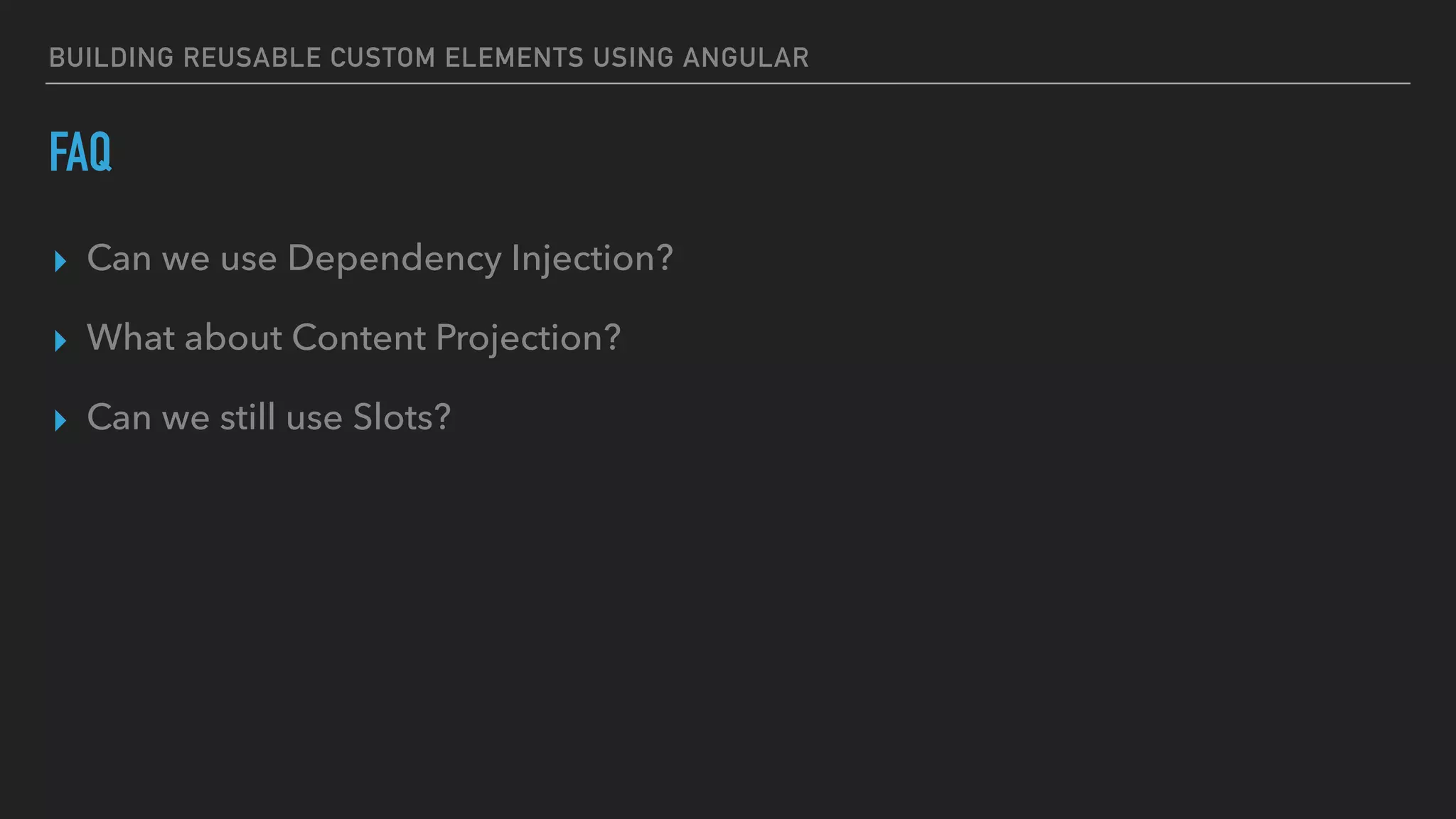The document discusses building reusable custom elements using Angular, focusing on web components and the principles of modular programming such as separation of concerns and S.O.L.I.D principles. It details the creation and usage of custom elements, including how to leverage shadow DOM, templates, and lifecycle callbacks, while also introducing Angular Elements for custom web components. Additionally, the document reviews the benefits and drawbacks of using custom components in web development and provides practical examples, including code snippets for implementation.

![A B O U T M E { "name": "Ilia Idakiev", "experience": [ "Developer & Founder of HNS/HG“, "Lecturer in 'Advanced JS' @ Sofia University”, "Contractor / Consultant", “Public / Private Courses“ ], "involvedIn": [ "SofiaJS", "BeerJS", "Angular Sofia" ] }](https://image.slidesharecdn.com/customelementswithangular-180903103003/75/Building-Reusable-Custom-Elements-With-Angular-2-2048.jpg)

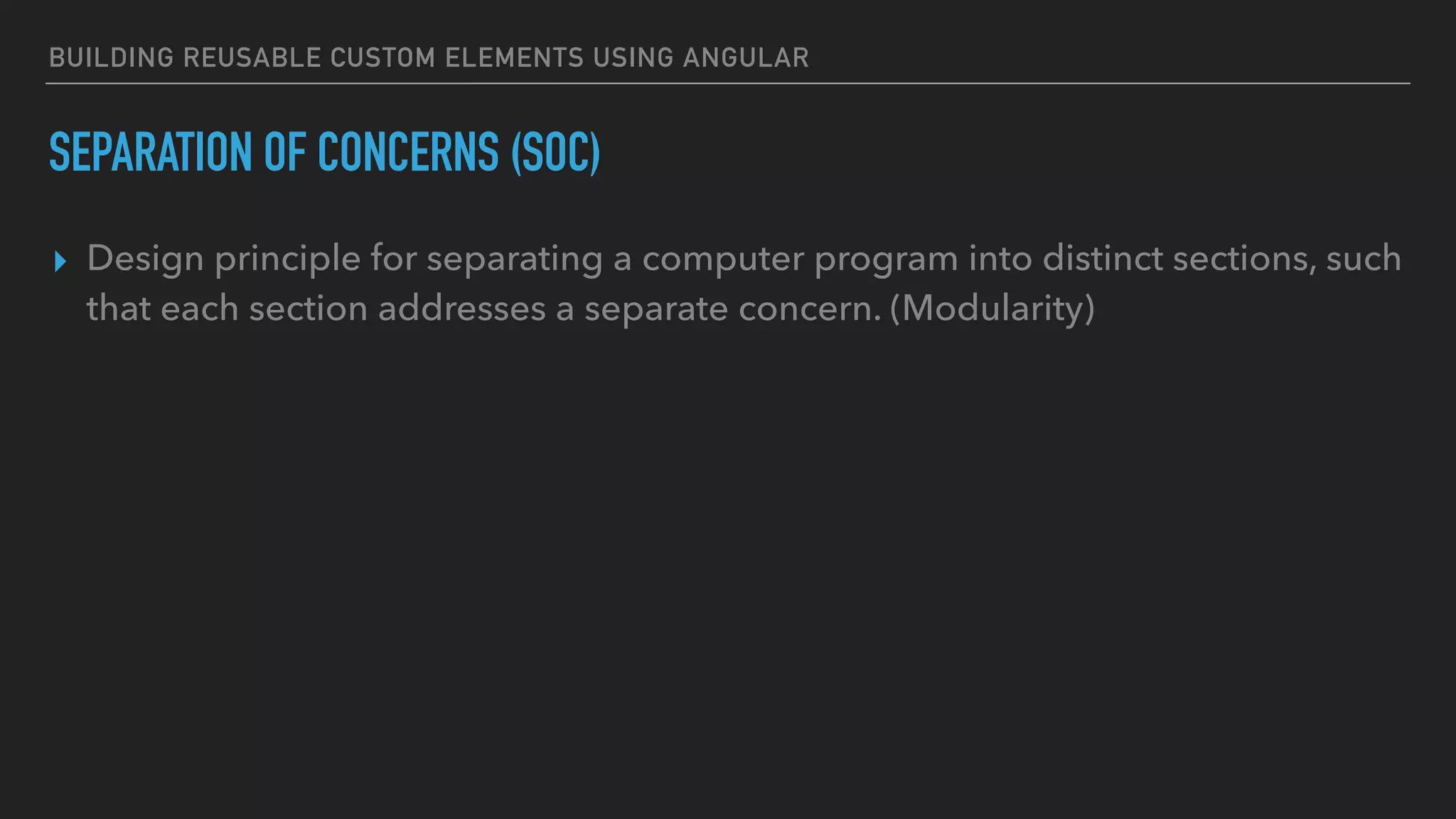
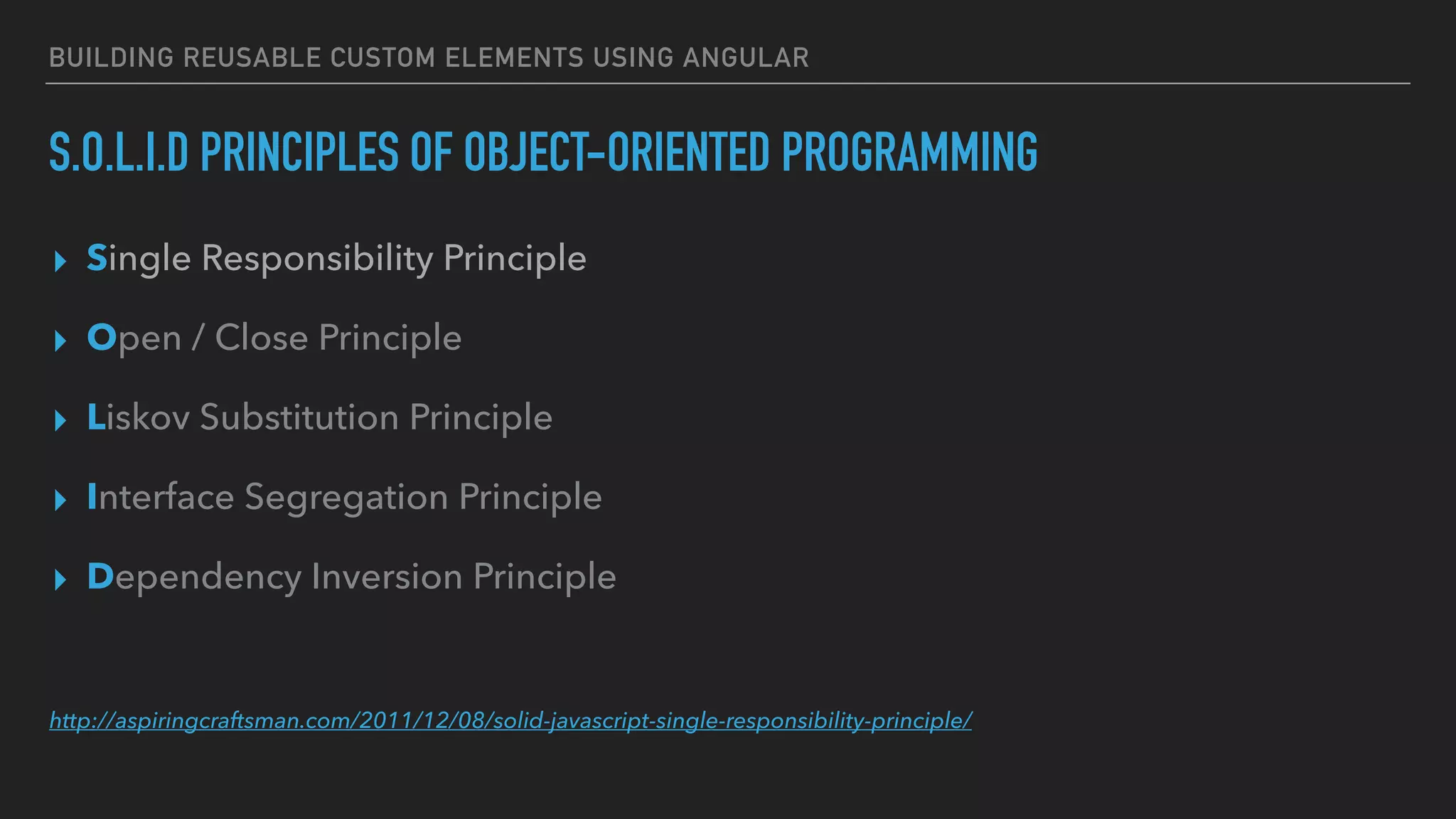
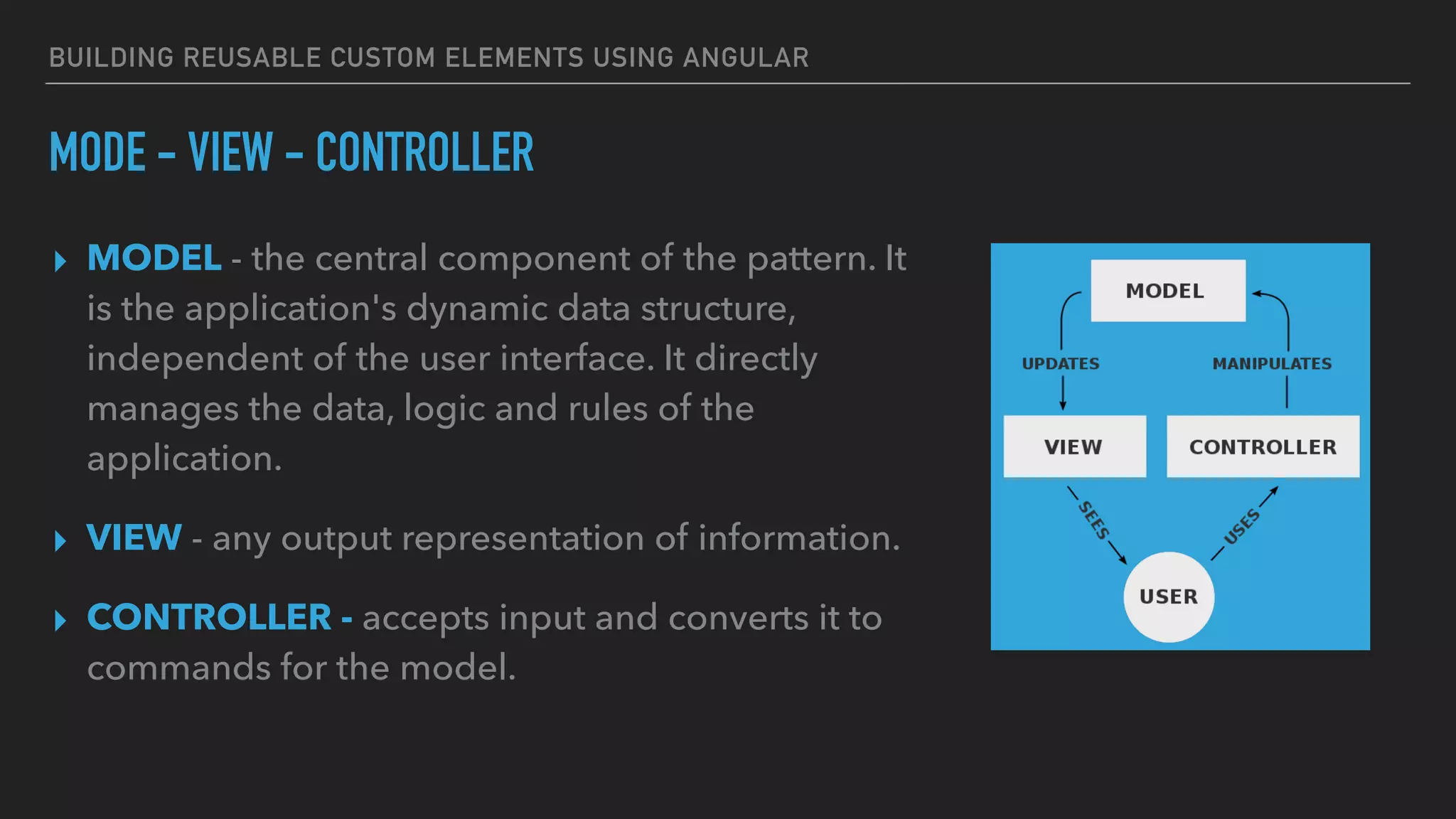

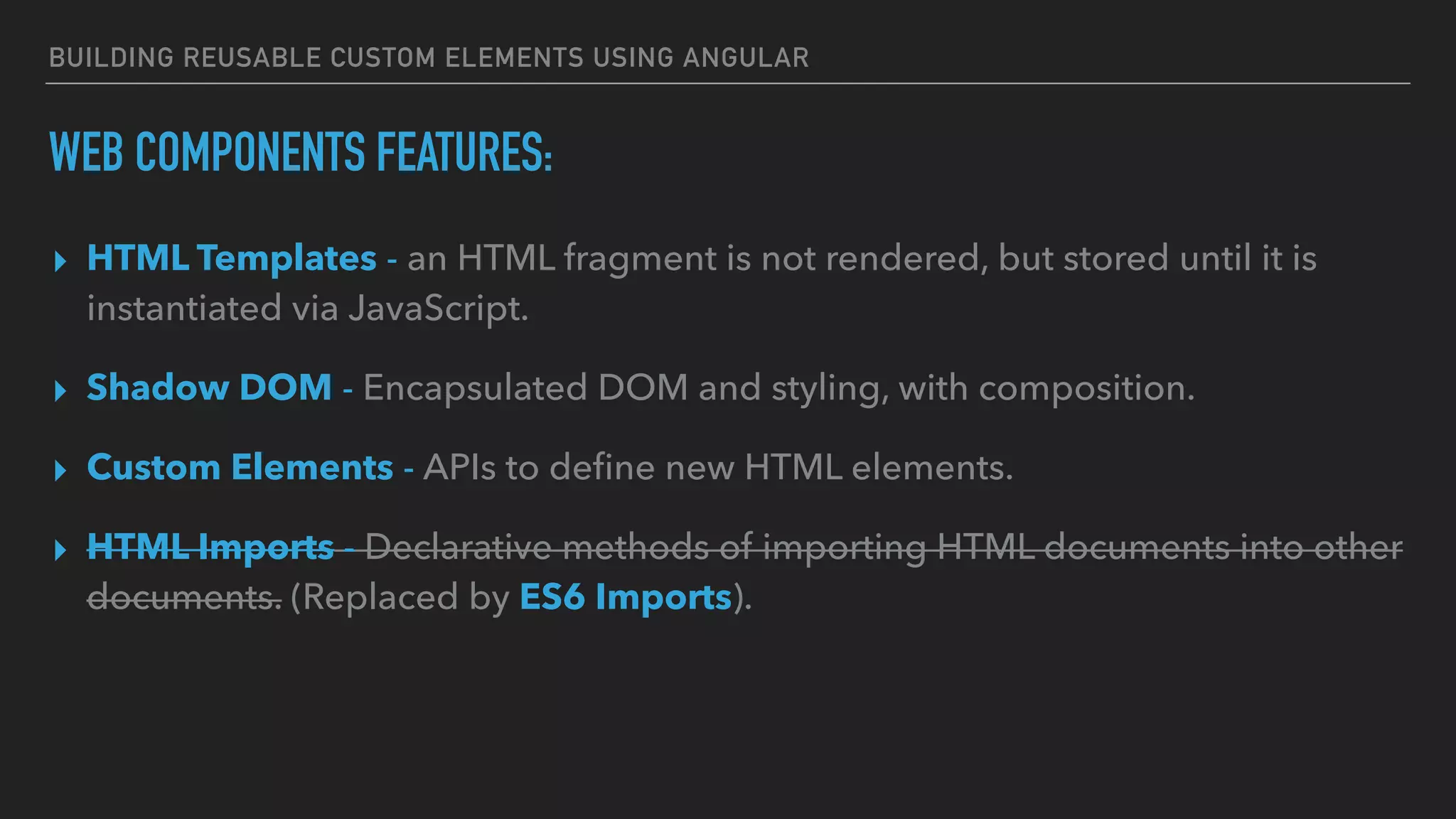


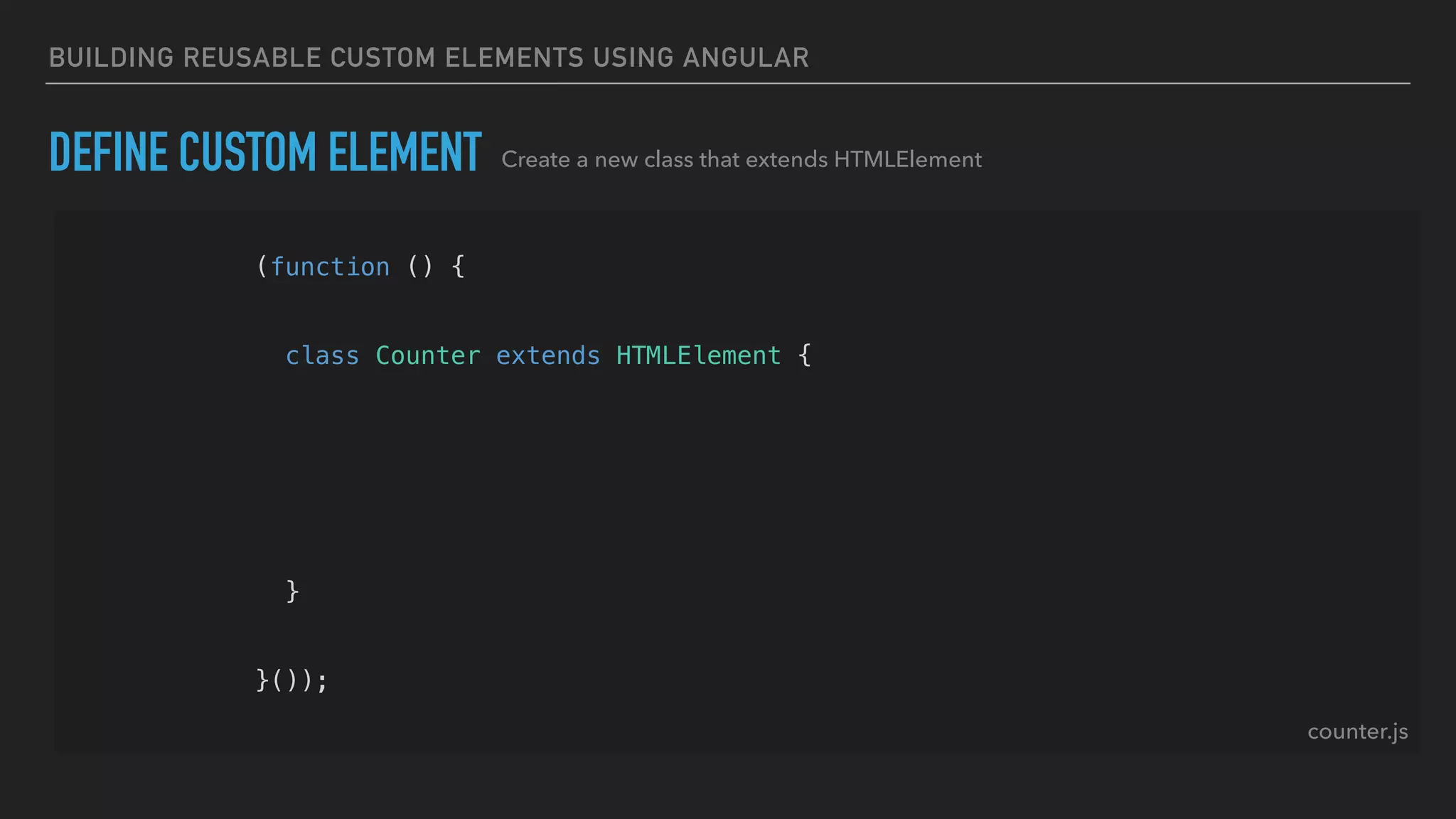
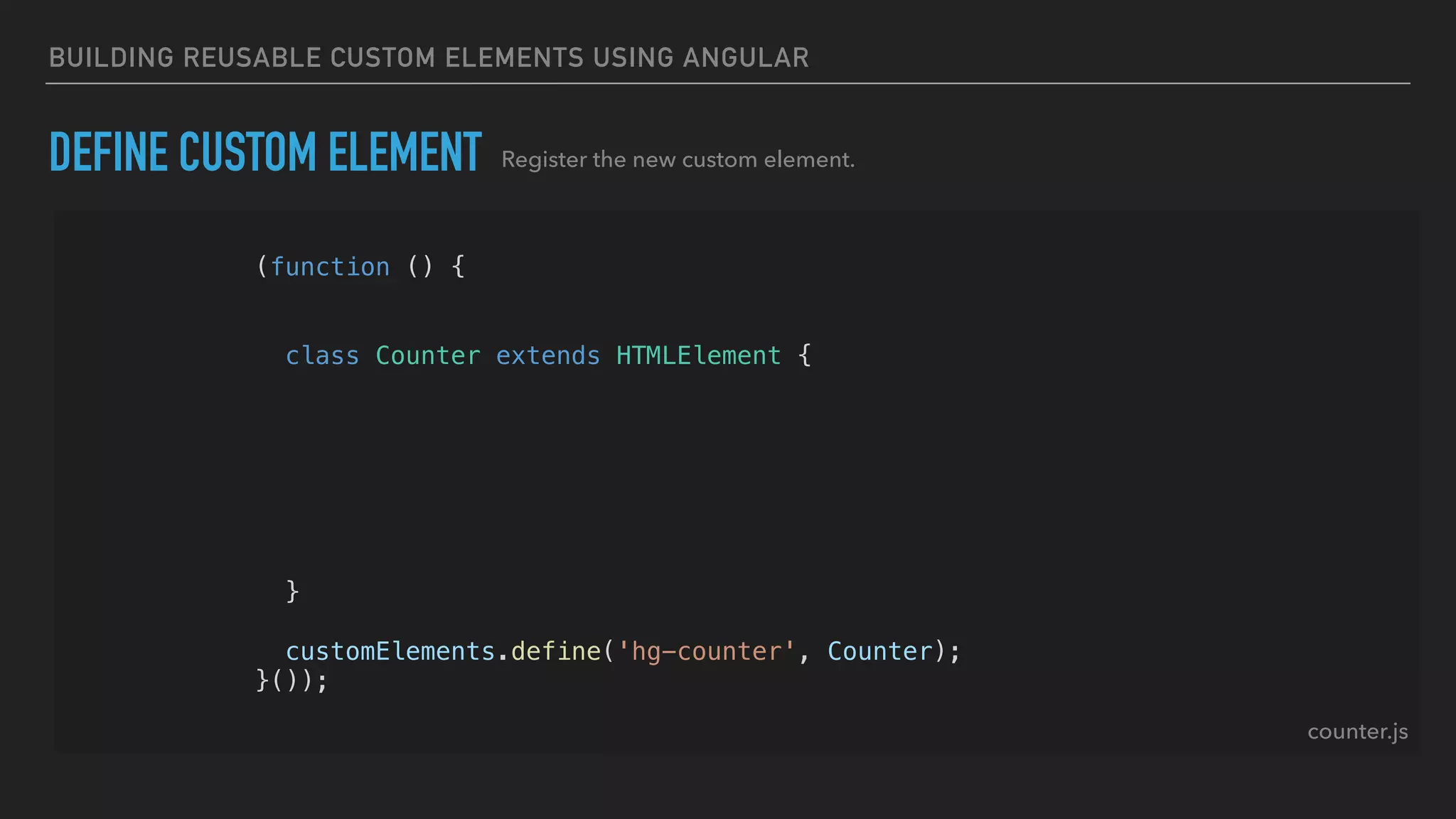
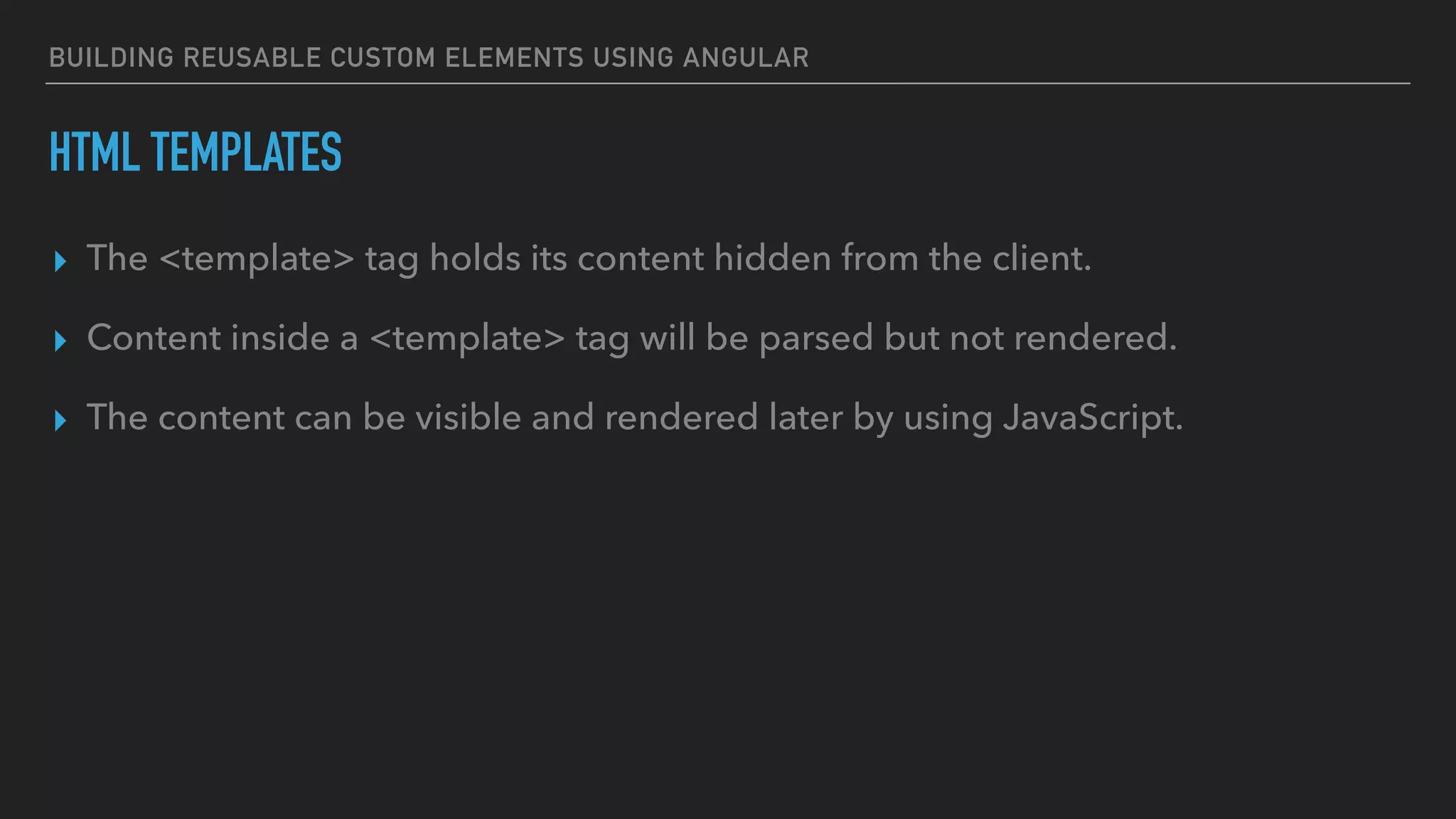
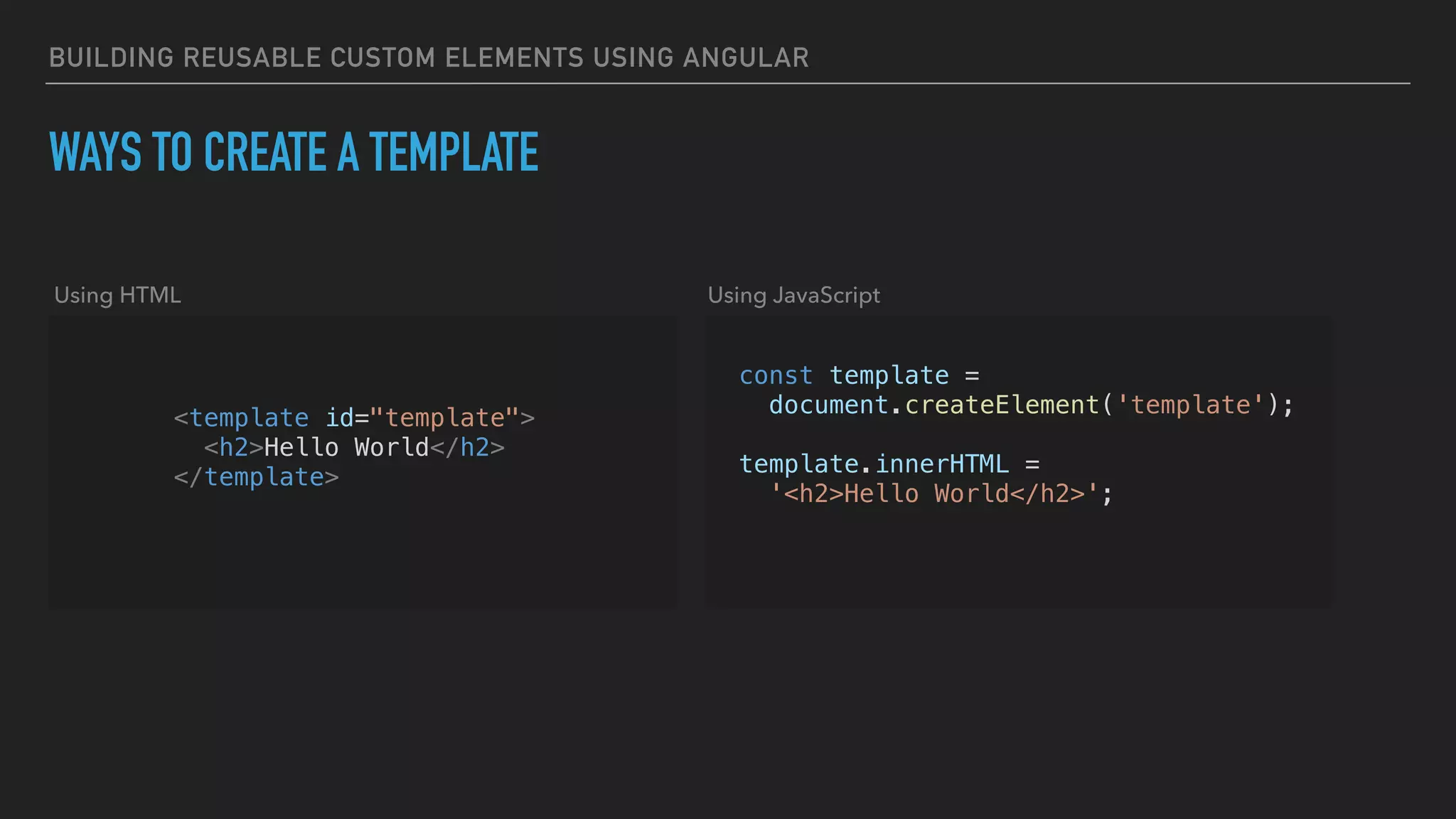
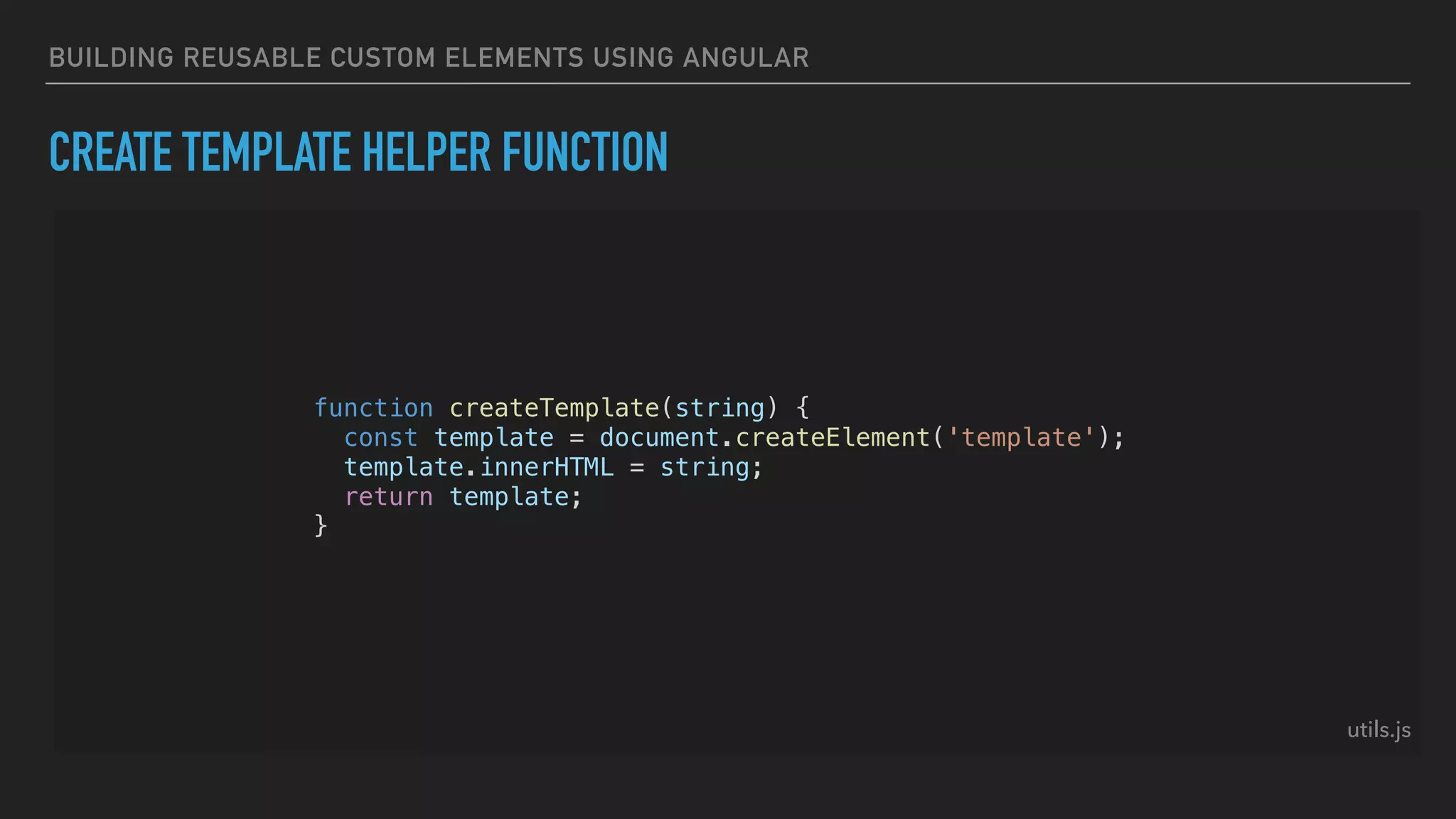
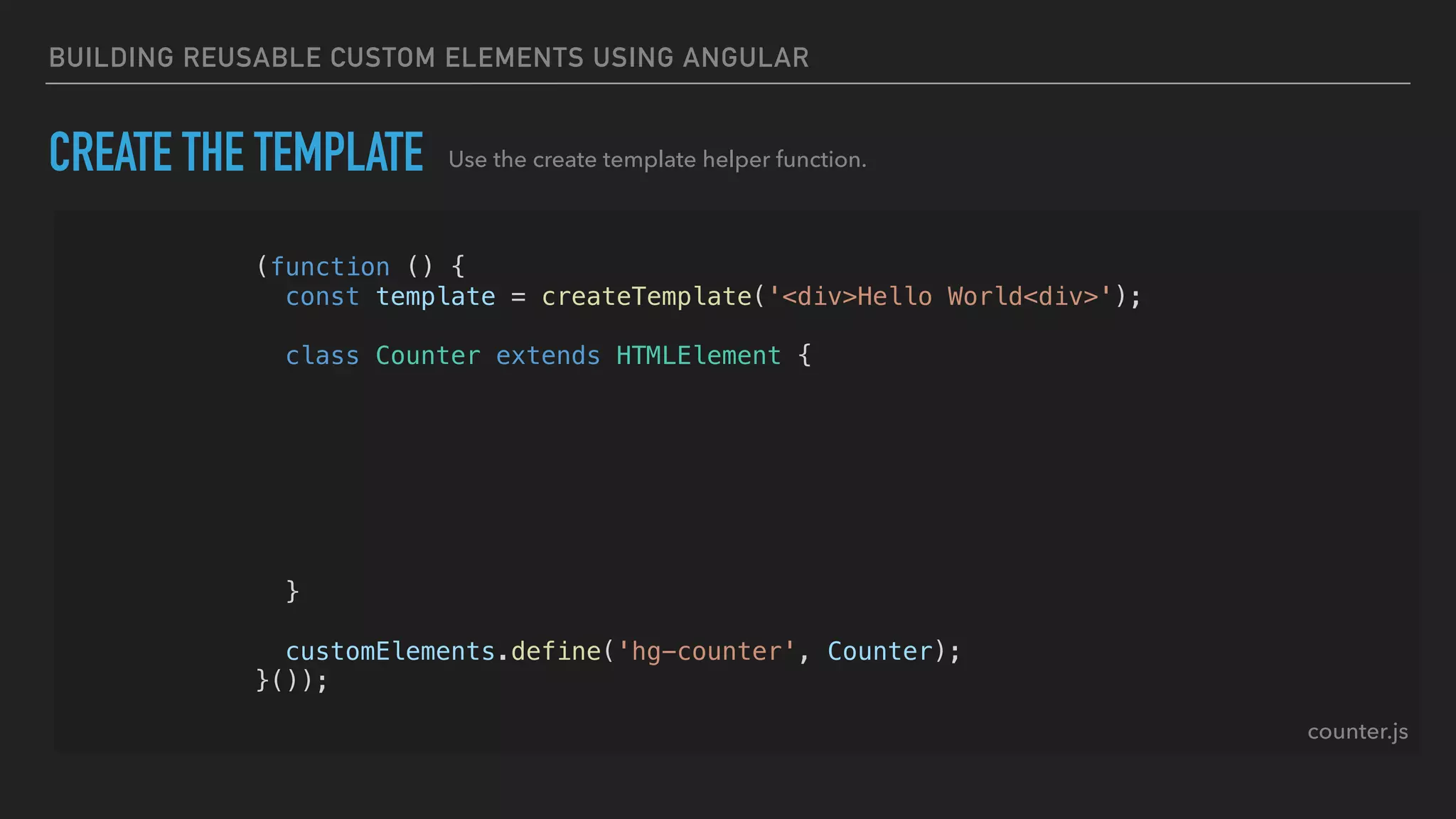
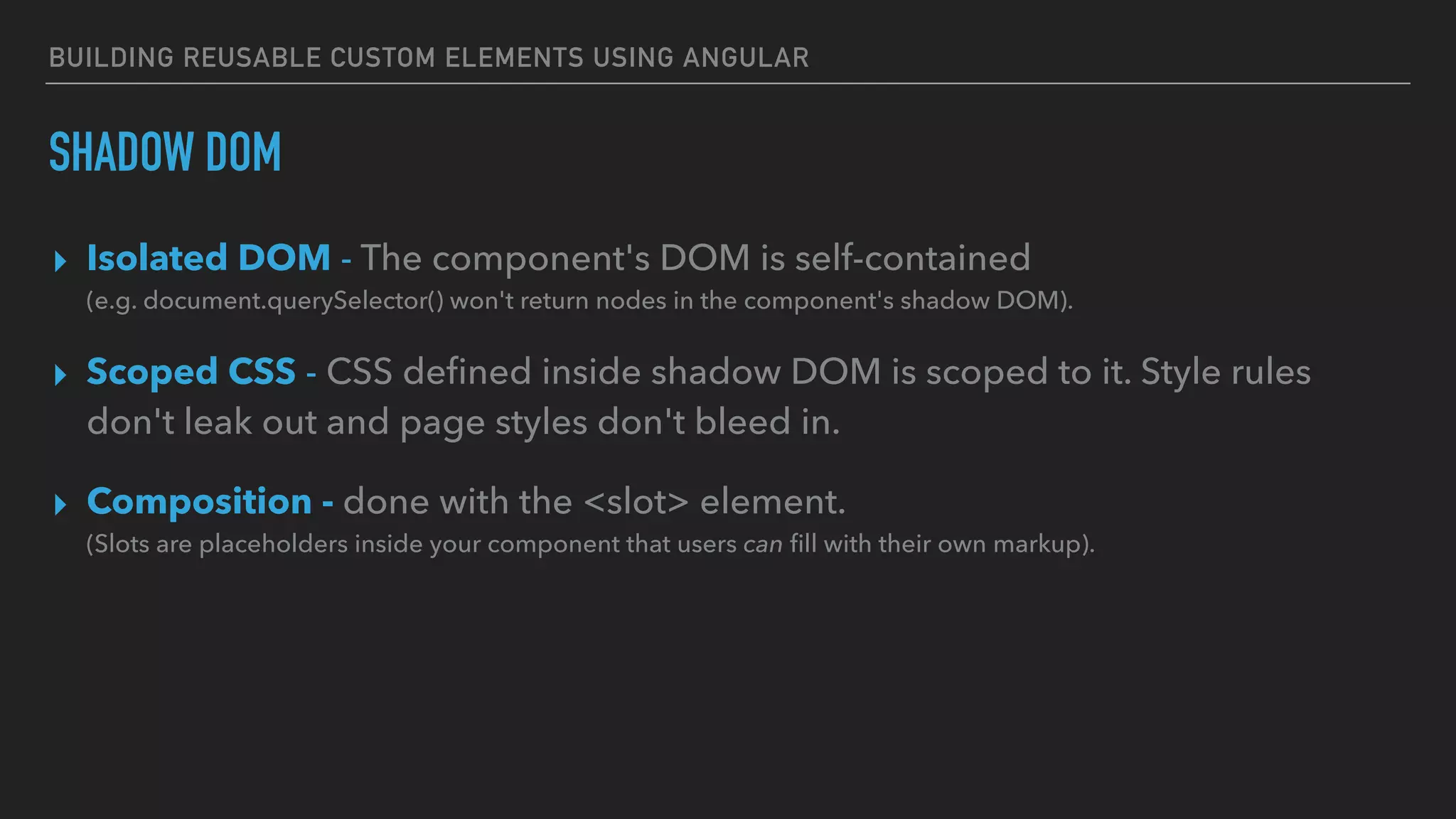
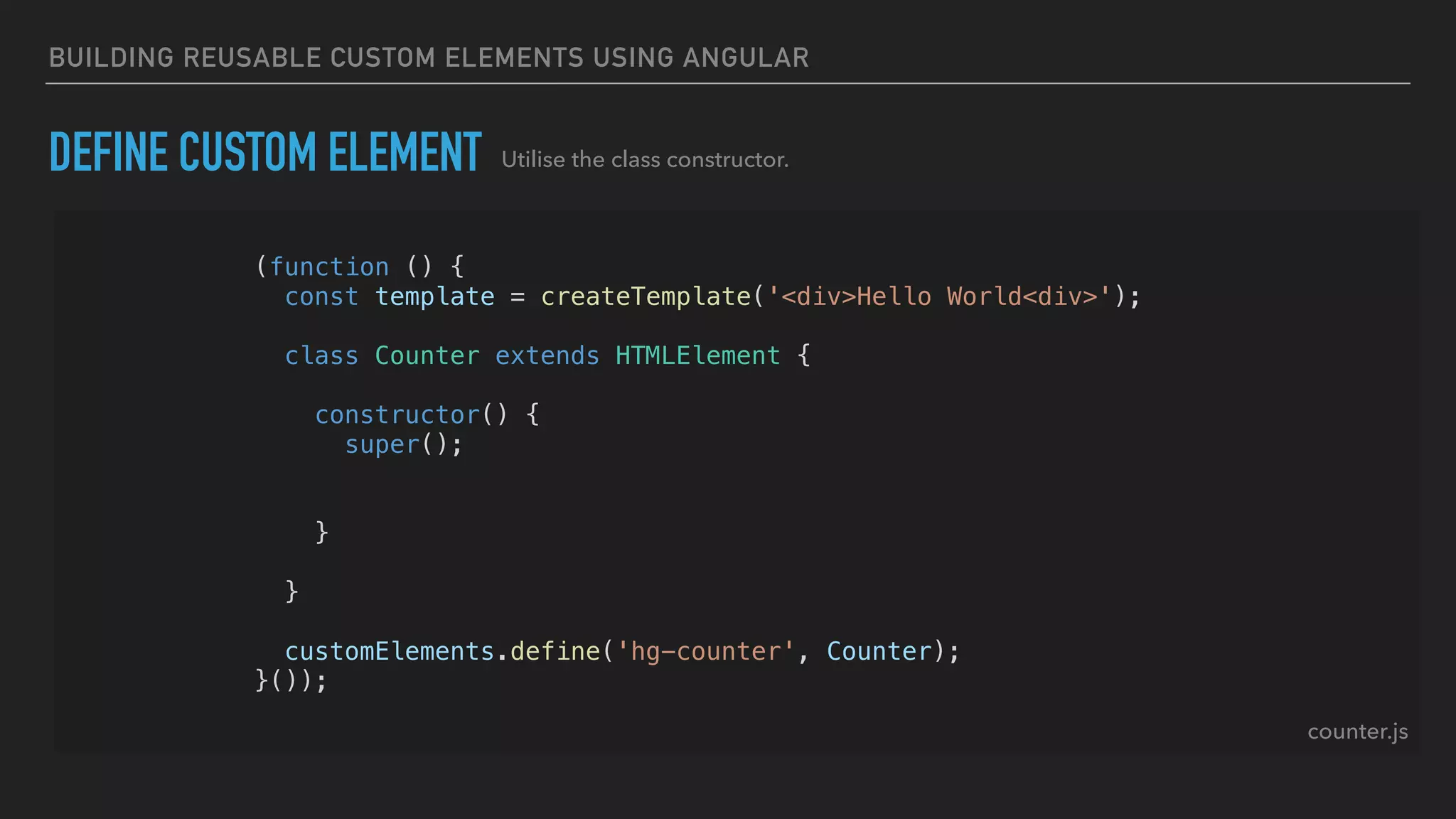
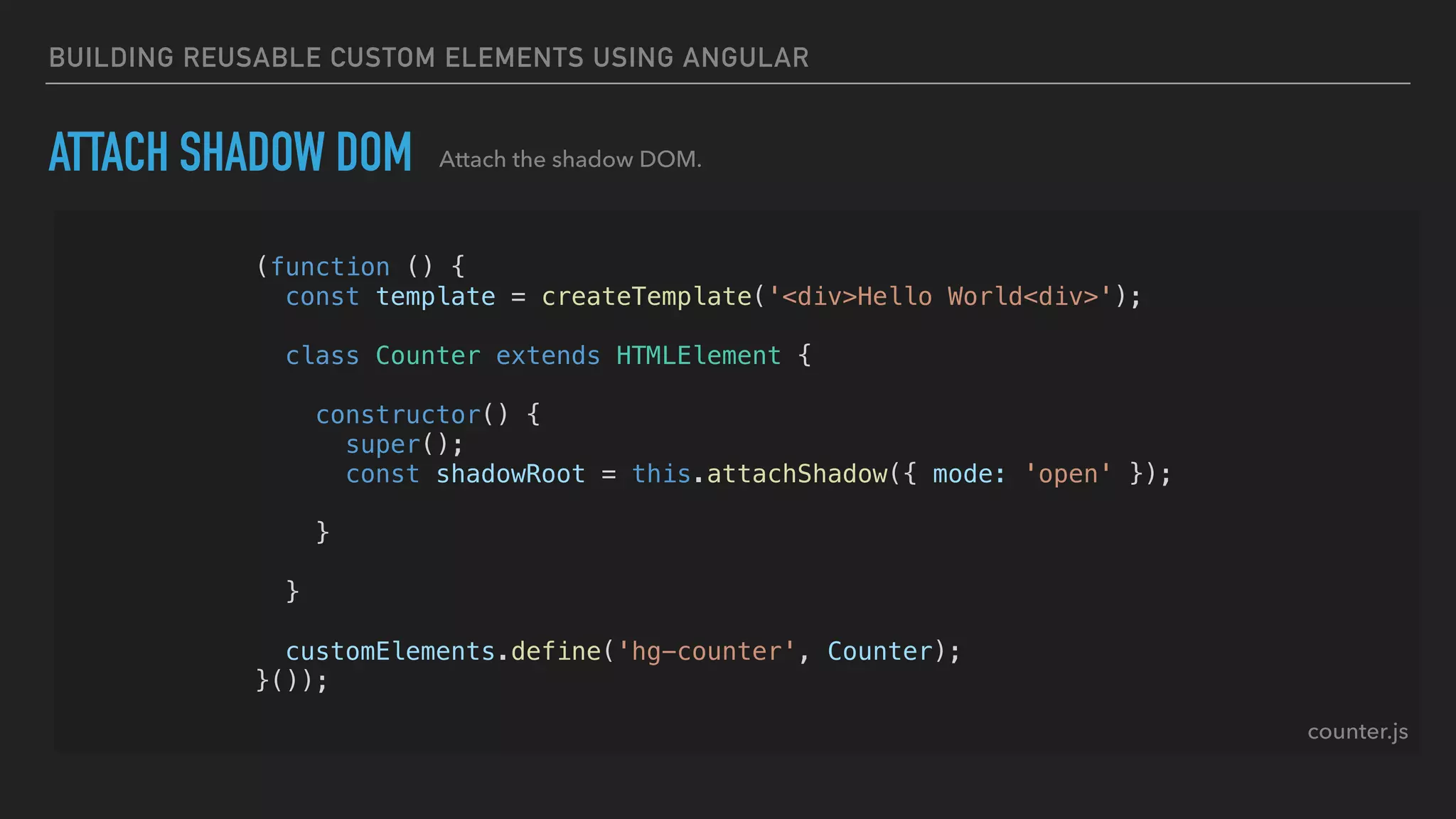
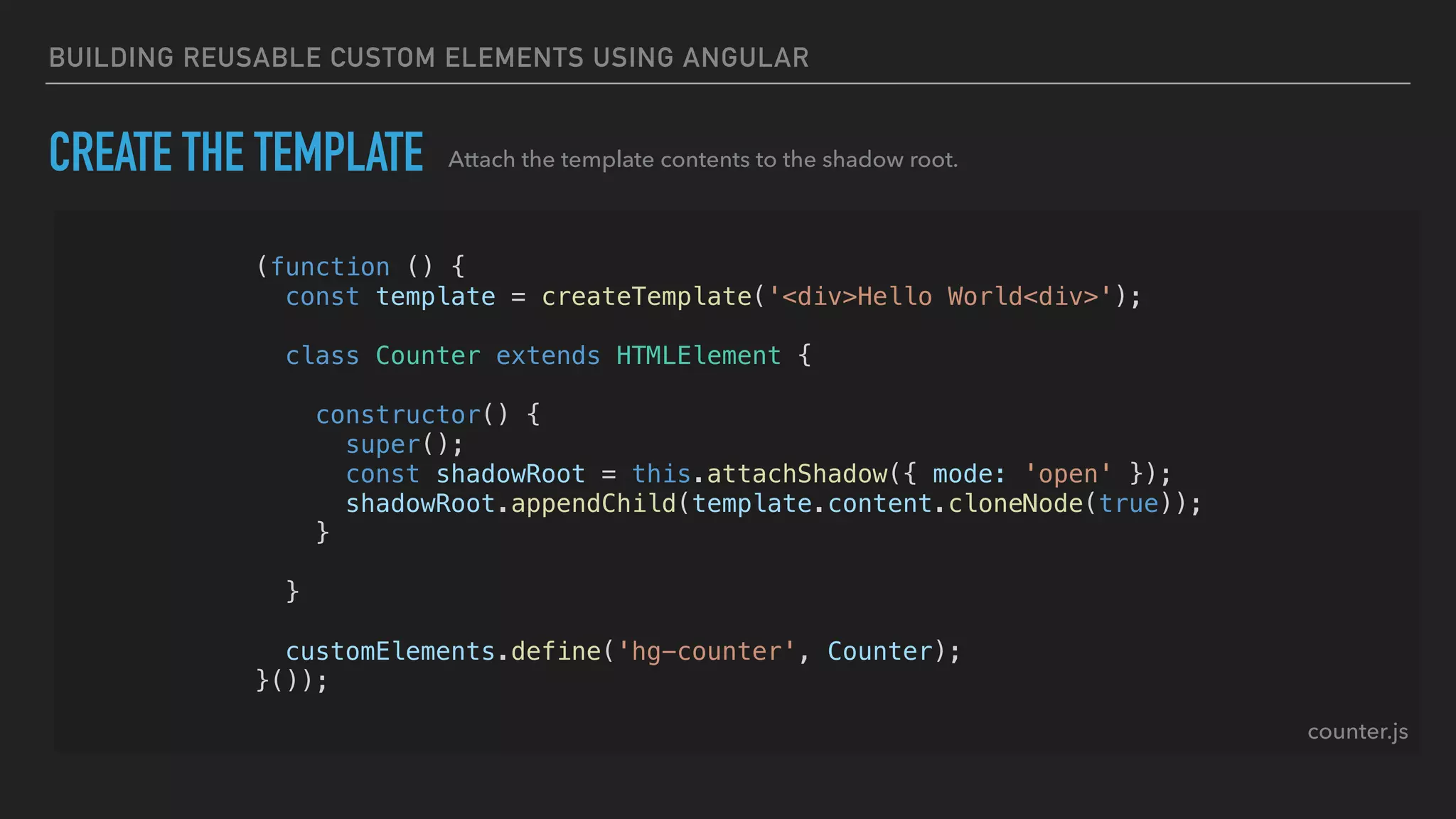
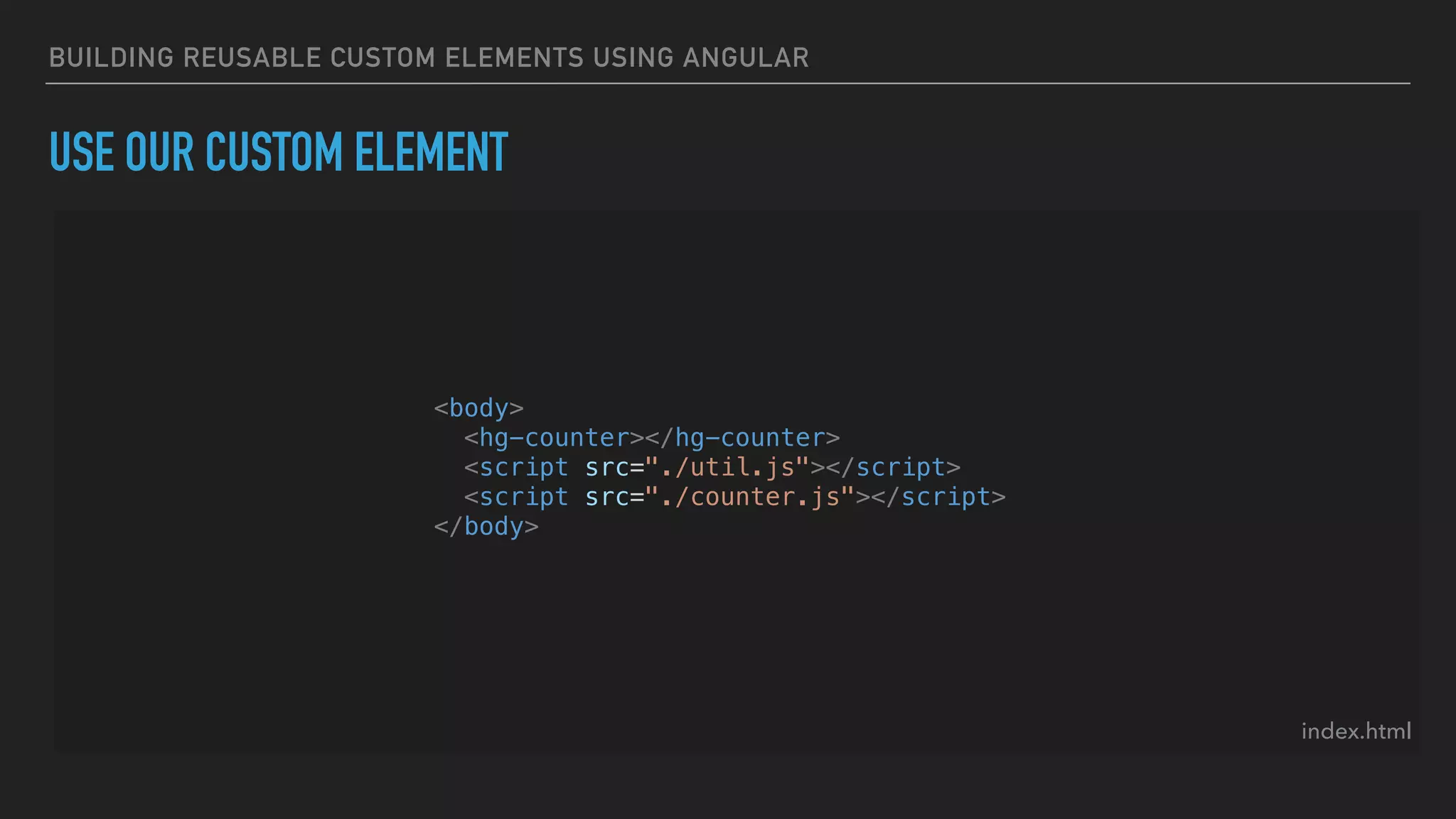
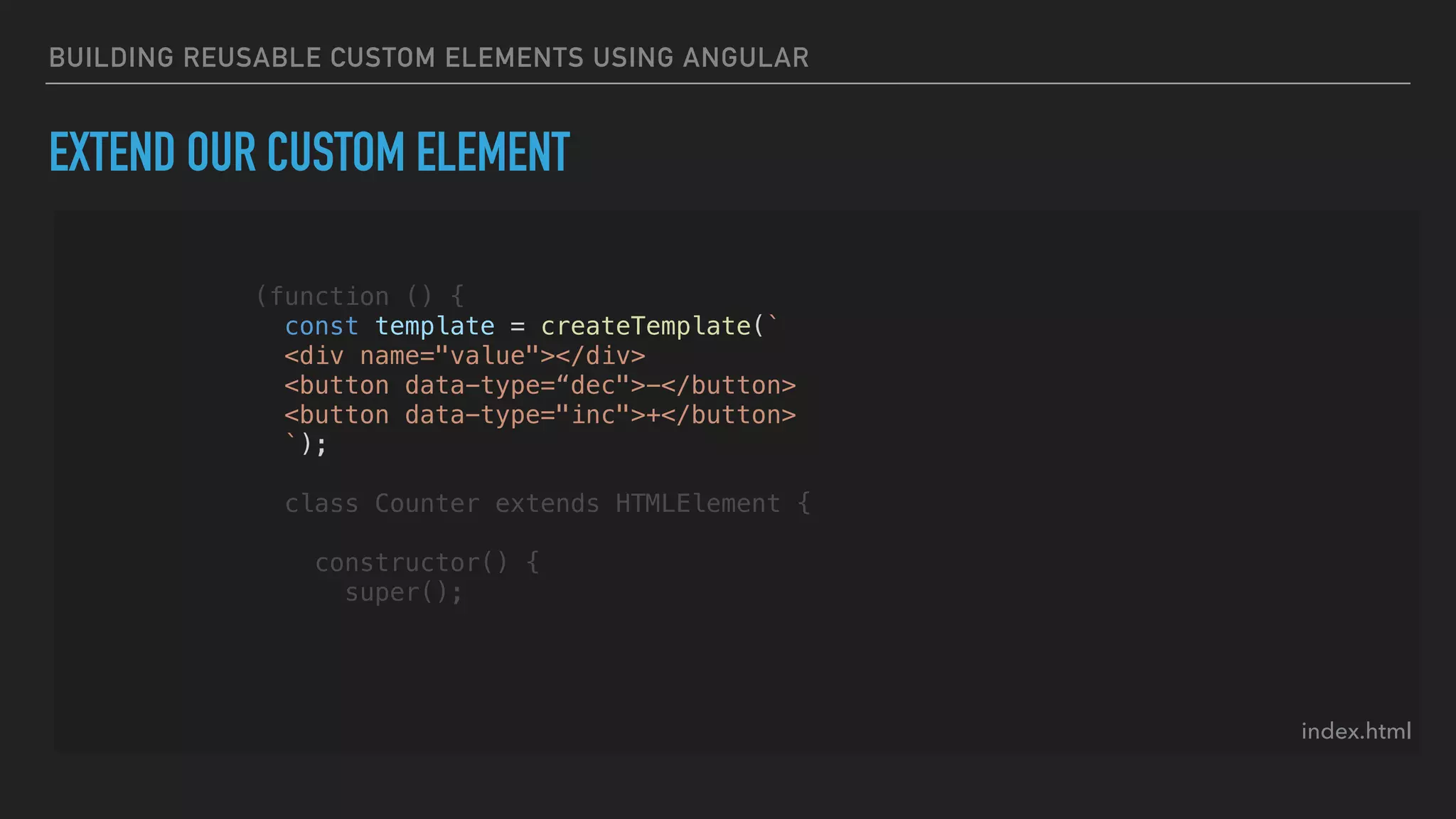
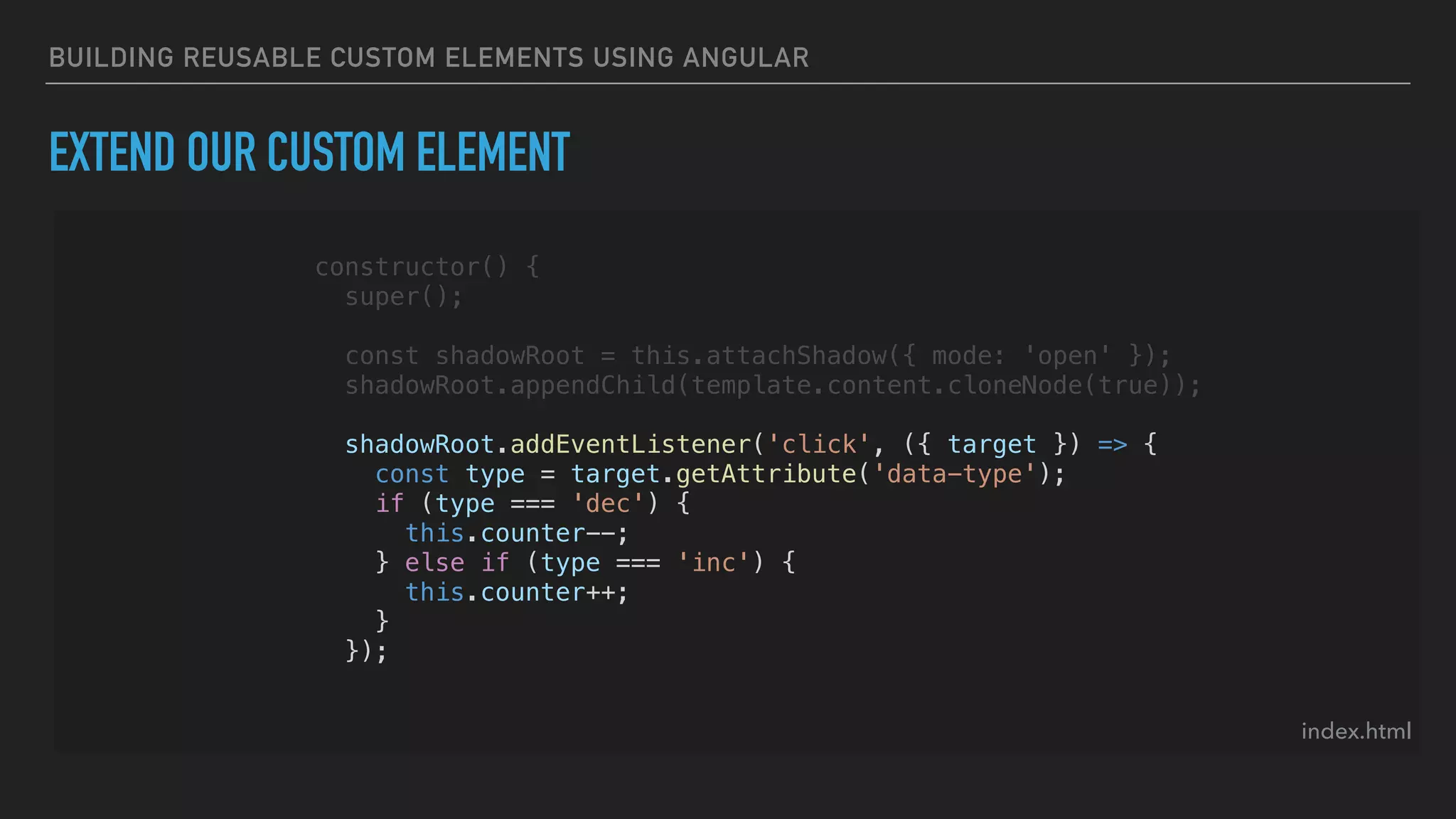
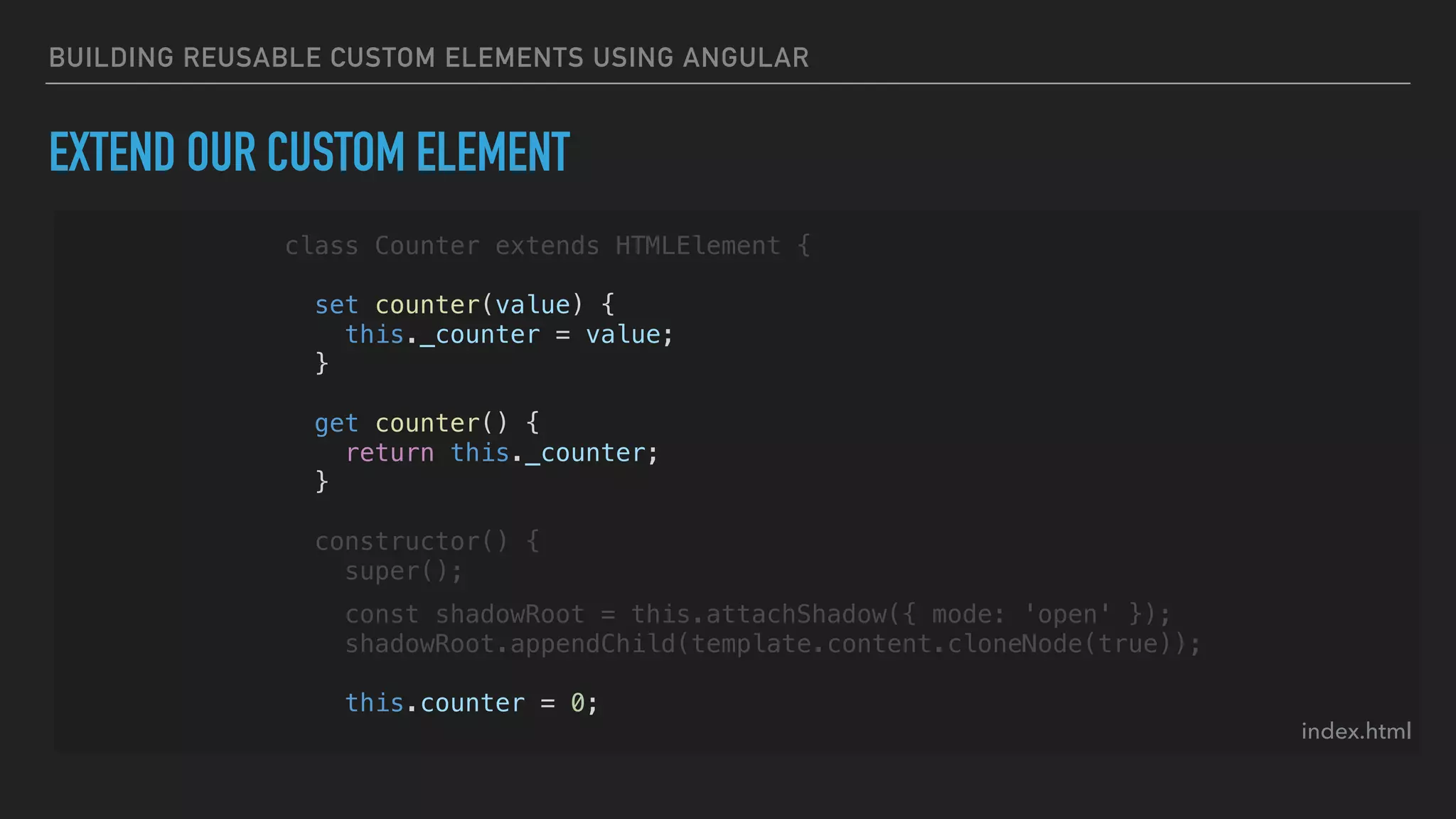
![BUILDING REUSABLE CUSTOM ELEMENTS USING ANGULAR UPDATING THE DOM utils.js function updateDOM(root, updates) { updates.forEach(item => { root.querySelectorAll(`[name=${item.name}]`).forEach(element => element.textContent = item.value ); }); }](https://image.slidesharecdn.com/customelementswithangular-180903103003/75/Building-Reusable-Custom-Elements-With-Angular-25-2048.jpg)
![BUILDING REUSABLE CUSTOM ELEMENTS USING ANGULAR EXTEND OUR CUSTOM ELEMENT index.html class Counter extends HTMLElement { constructor() { super(); const shadowRoot = this.attachShadow({ mode: 'open' }); shadowRoot.appendChild(template.content.cloneNode(true)); this.counter = 0; this._update = () => { updateDOM(shadowRoot, [{ name: 'value', value: this.counter }]); }](https://image.slidesharecdn.com/customelementswithangular-180903103003/75/Building-Reusable-Custom-Elements-With-Angular-26-2048.jpg)
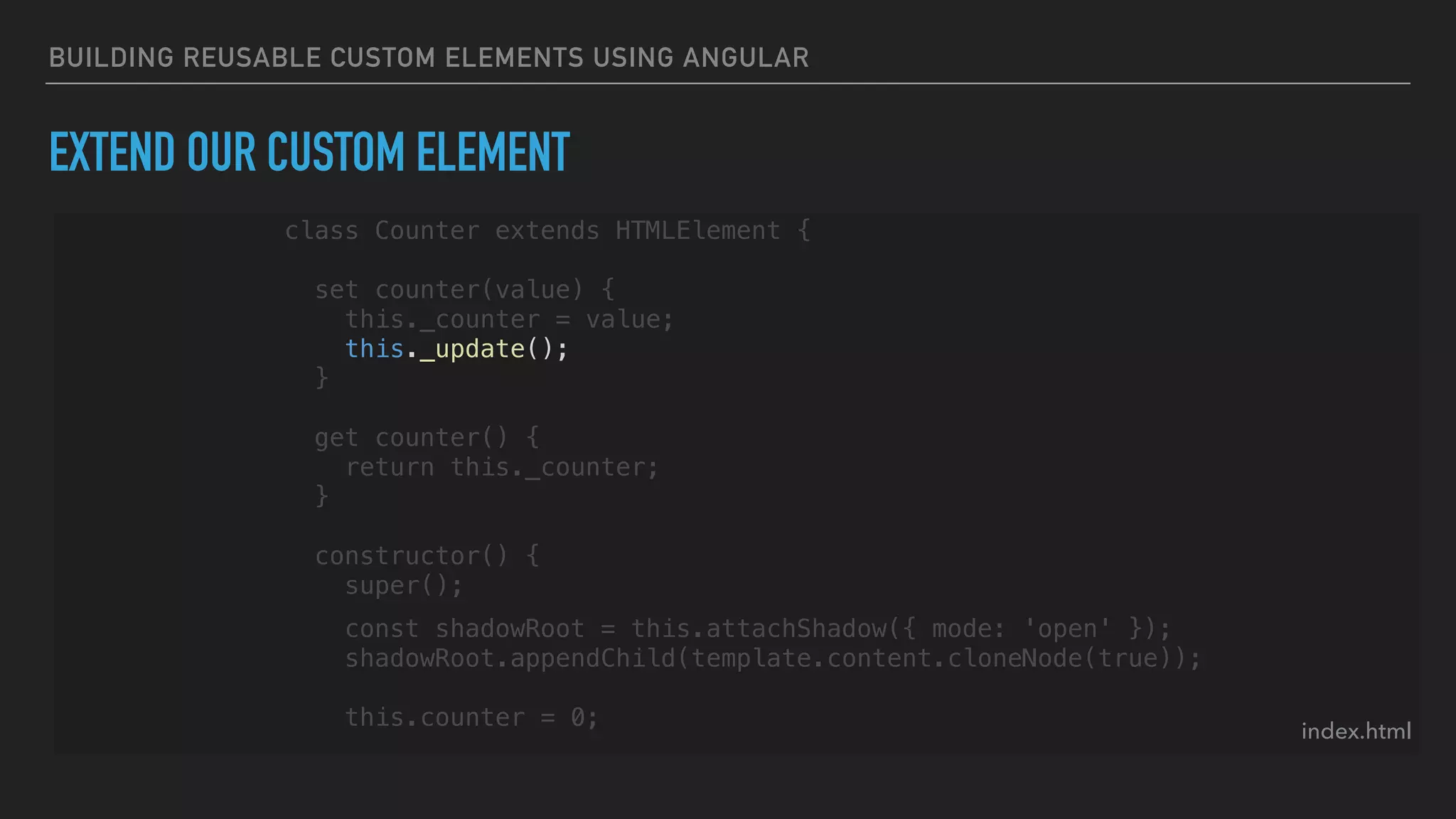
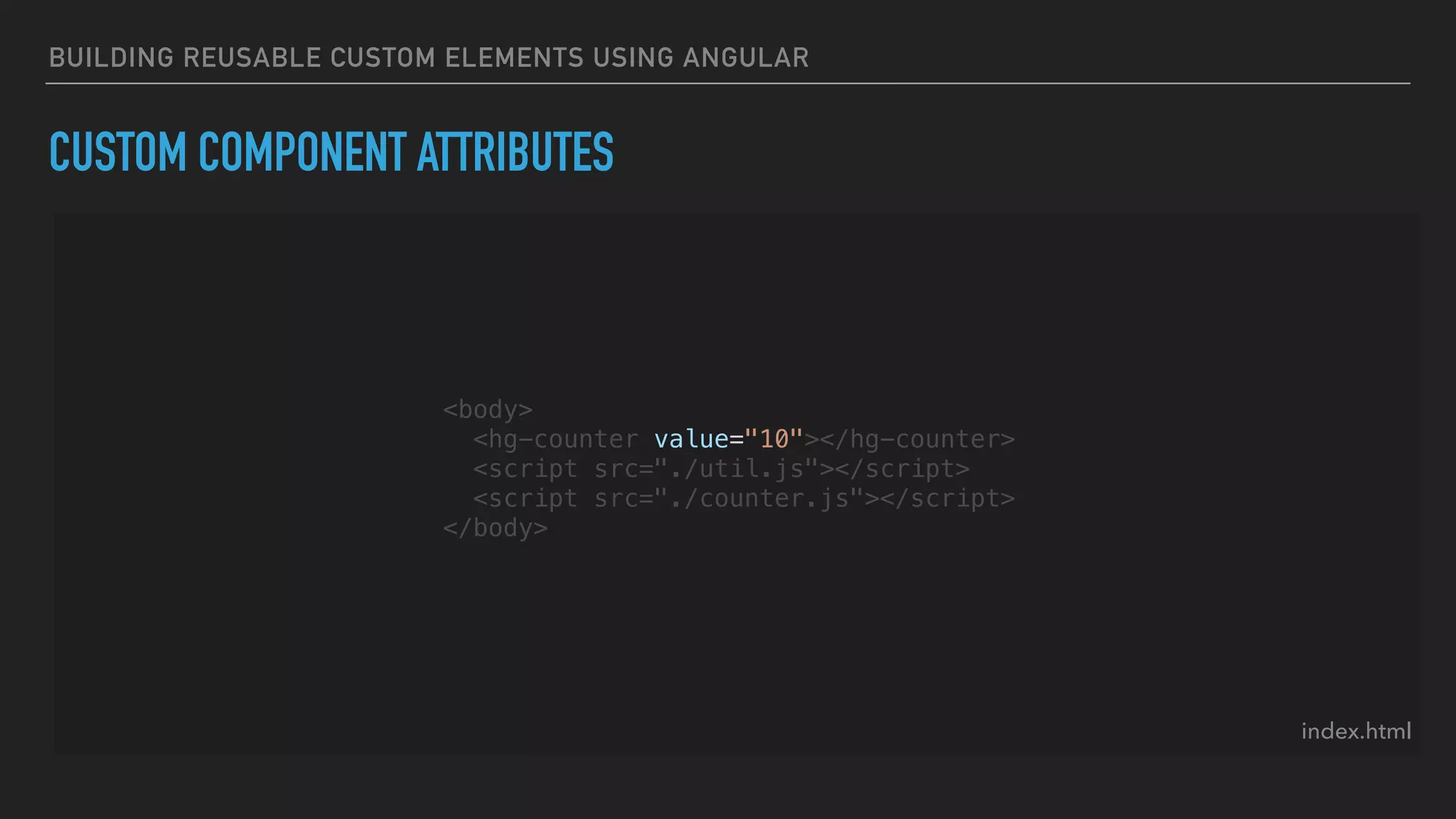
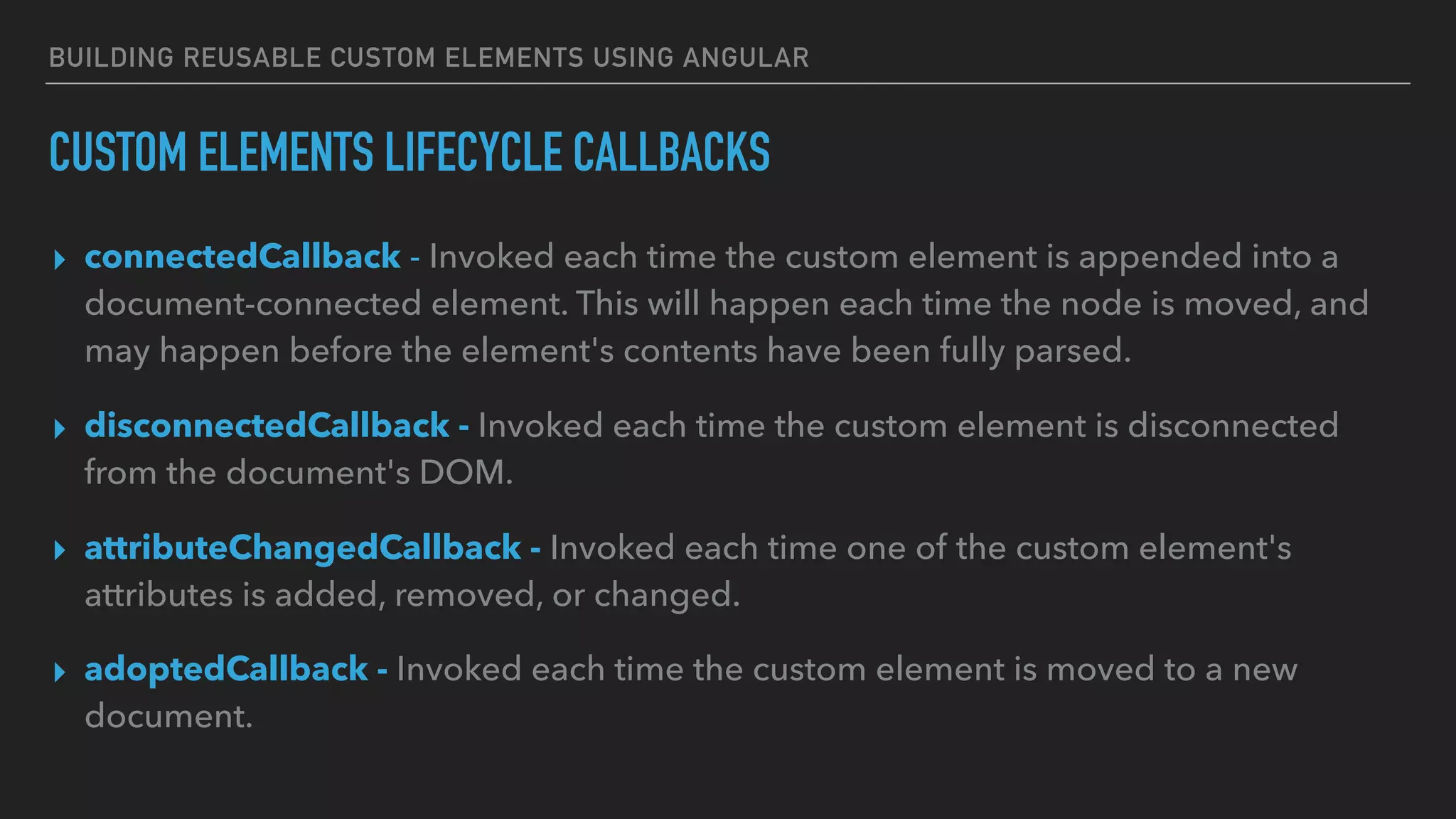
![BUILDING REUSABLE CUSTOM ELEMENTS USING ANGULAR CUSTOM COMPONENT ATTRIBUTES index.html class Counter extends HTMLElement { static get observedAttributes() { return ['value']; } attributeChangedCallback(name, oldValue, newValue) { if (name === 'value') { this.counter = newValue; } } constructor() { Handle attribute changes](https://image.slidesharecdn.com/customelementswithangular-180903103003/75/Building-Reusable-Custom-Elements-With-Angular-30-2048.jpg)
![BUILDING REUSABLE CUSTOM ELEMENTS USING ANGULAR CUSTOM COMPONENT ATTRIBUTES index.html class Counter extends HTMLElement { static get observedAttributes() { return ['value']; } attributeChangedCallback(name, oldValue, newValue) { if (name === 'value') { this.counter = newValue; } } constructor() { Define which attributes should be watched](https://image.slidesharecdn.com/customelementswithangular-180903103003/75/Building-Reusable-Custom-Elements-With-Angular-31-2048.jpg)

![BUILDING REUSABLE CUSTOM ELEMENTS USING ANGULAR CUSTOM COMPONENT STYLES index.html Apply scoped styles to our component (function () { const template = createTemplate(` <style> :host { display: flex; } div[name="value"] { min-width: 30px; } </style> <div name="value"></div> <button data-type="dec">-</button> <button data-type="inc">+</button> `); class Counter extends HTMLElement {](https://image.slidesharecdn.com/customelementswithangular-180903103003/75/Building-Reusable-Custom-Elements-With-Angular-33-2048.jpg)
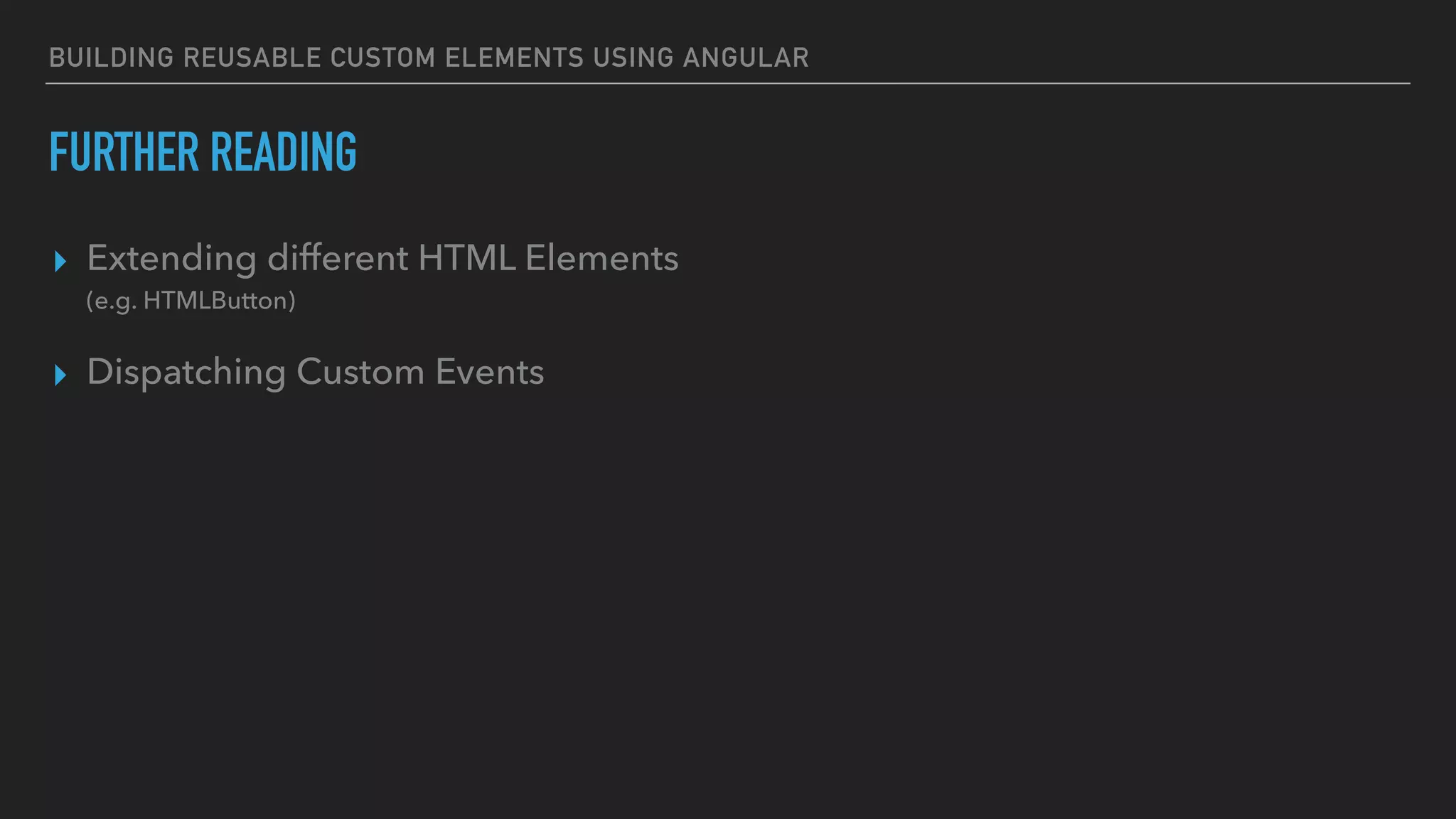

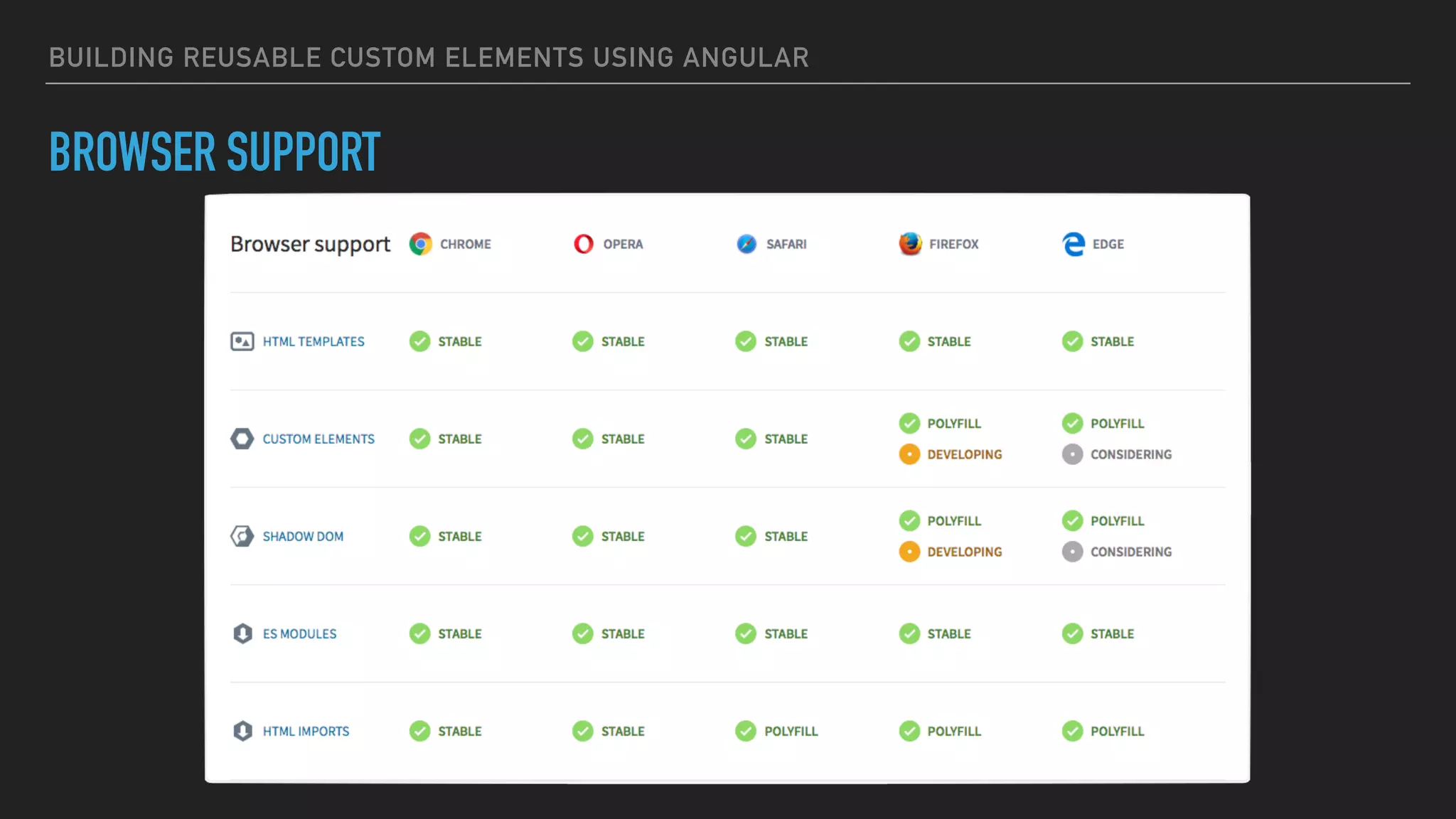
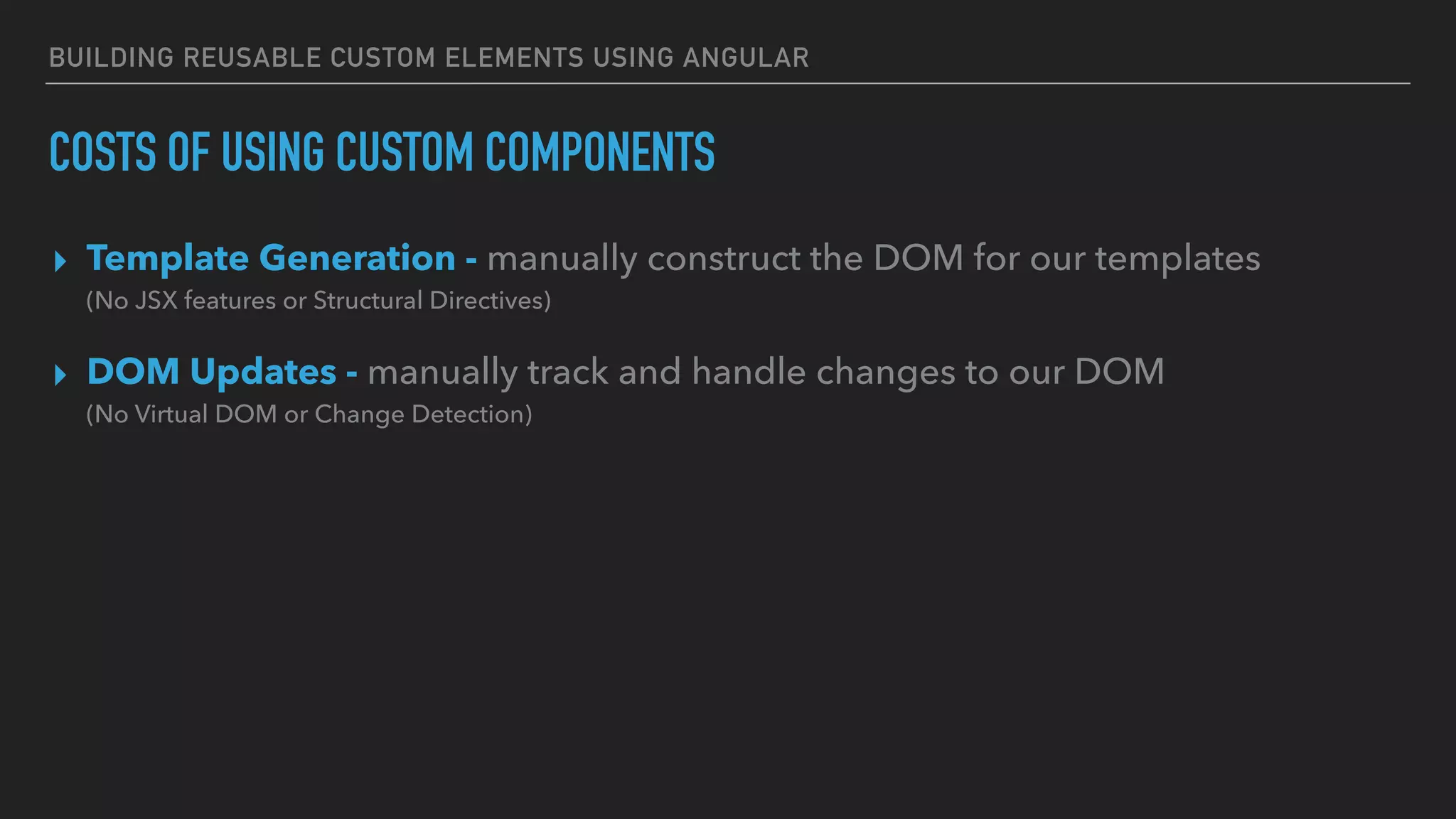

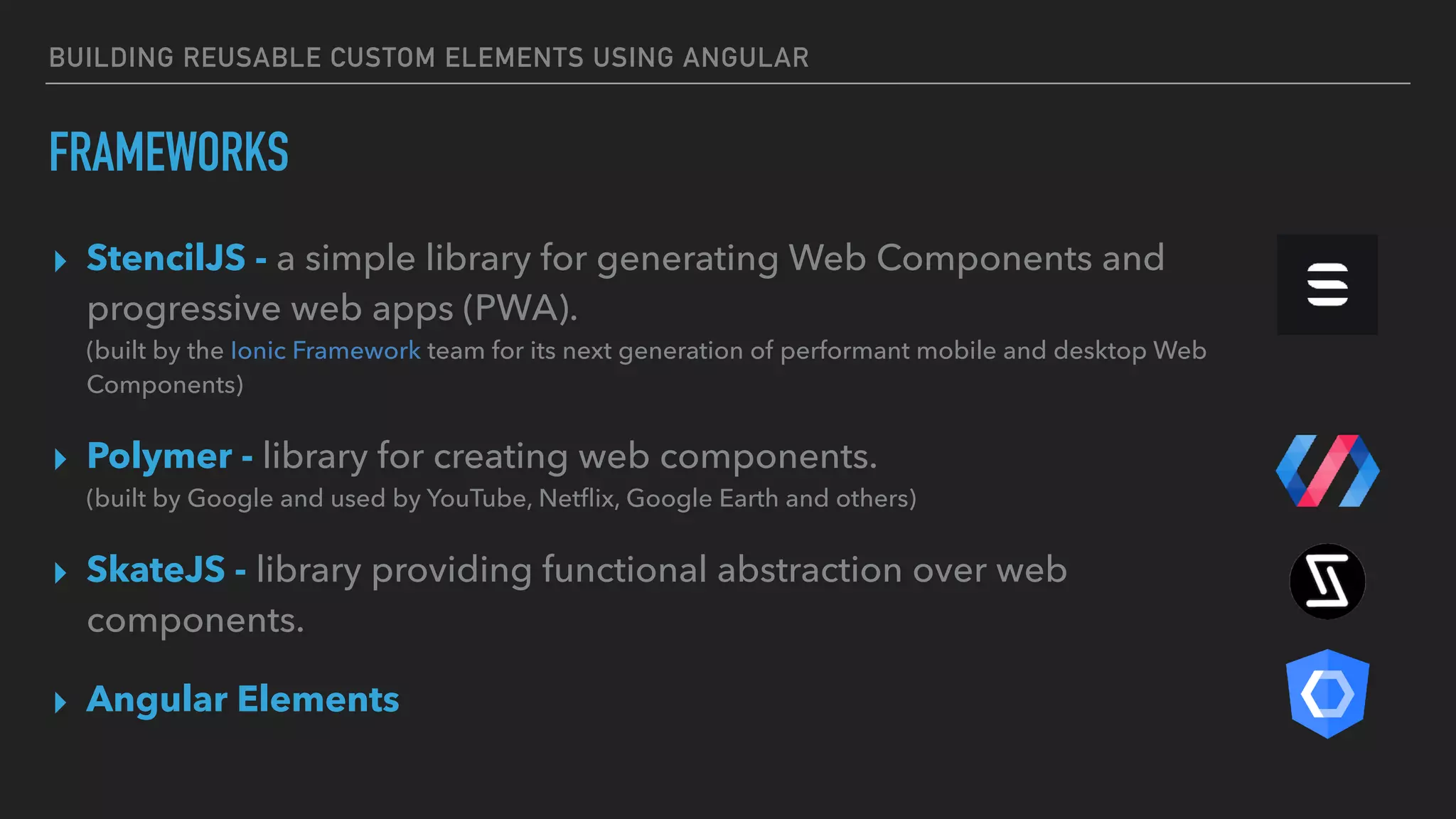
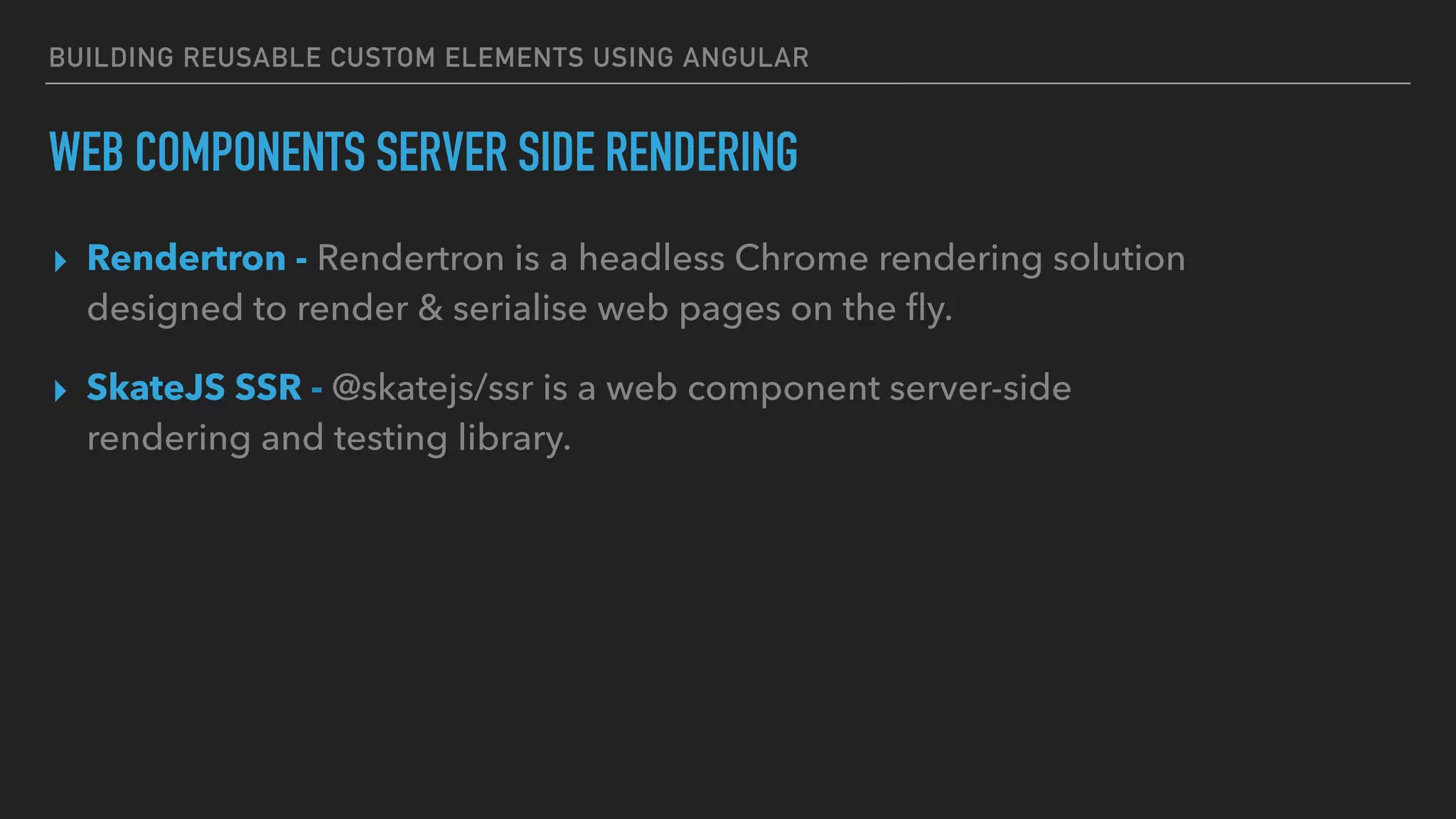

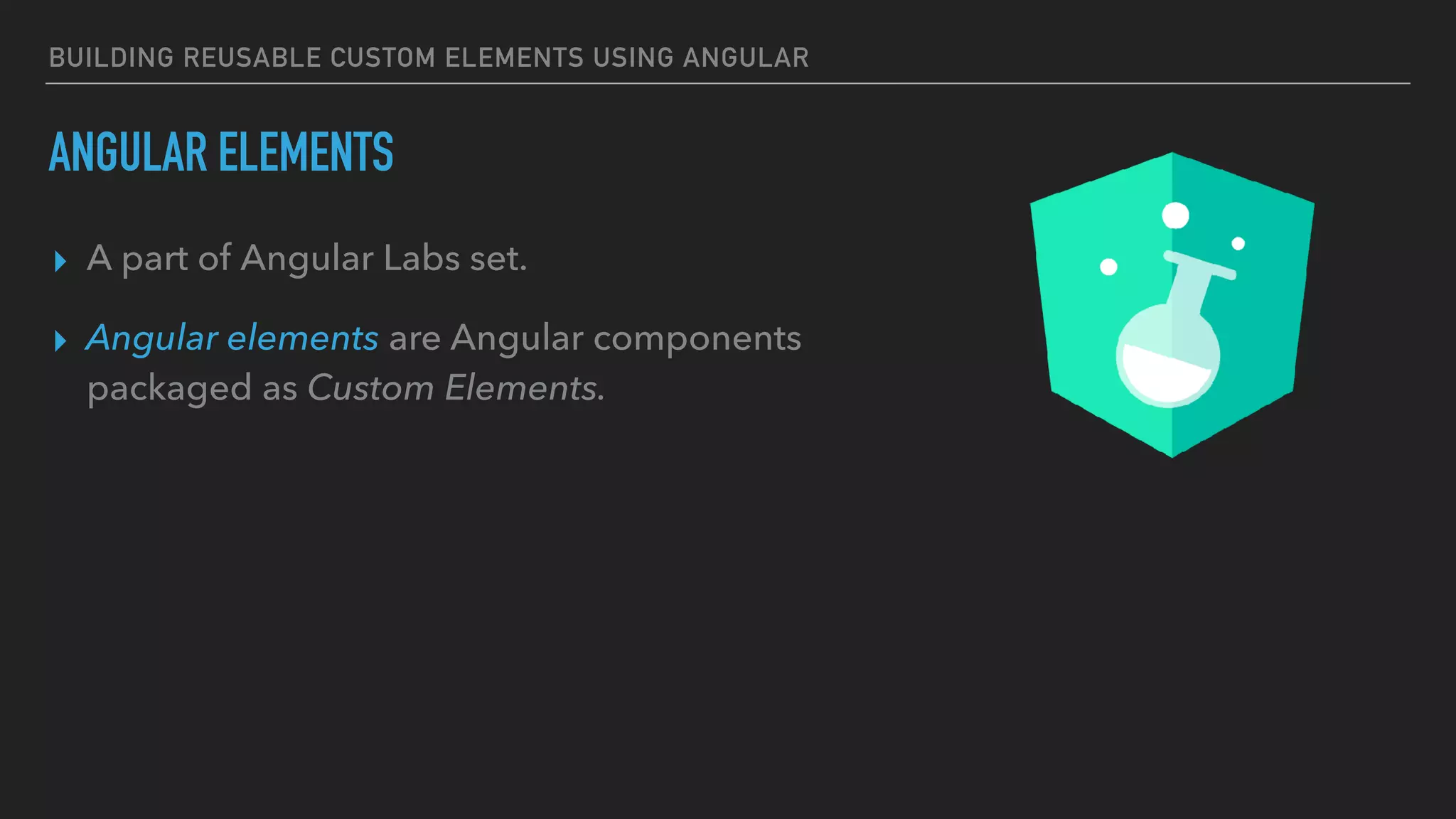
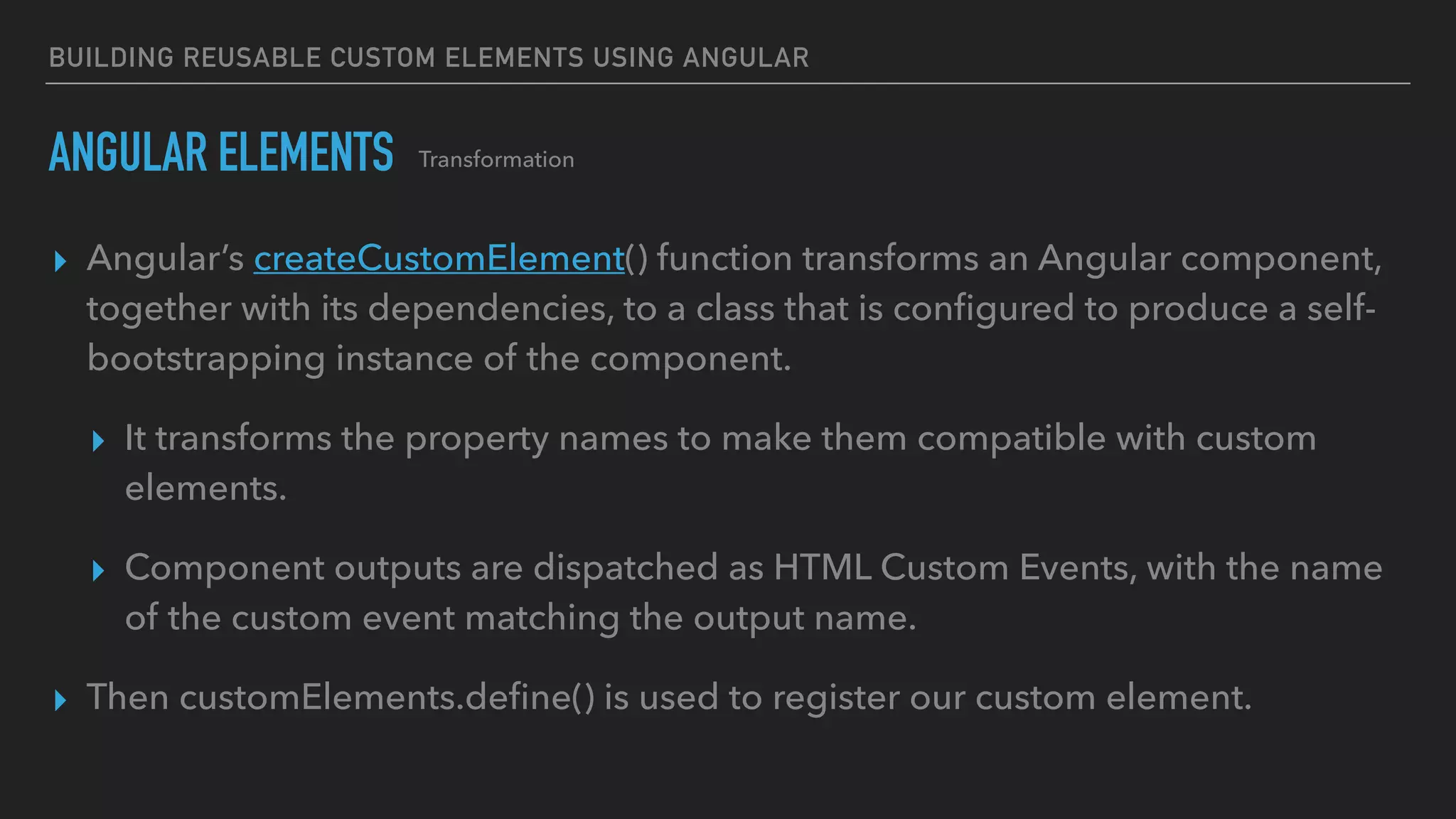

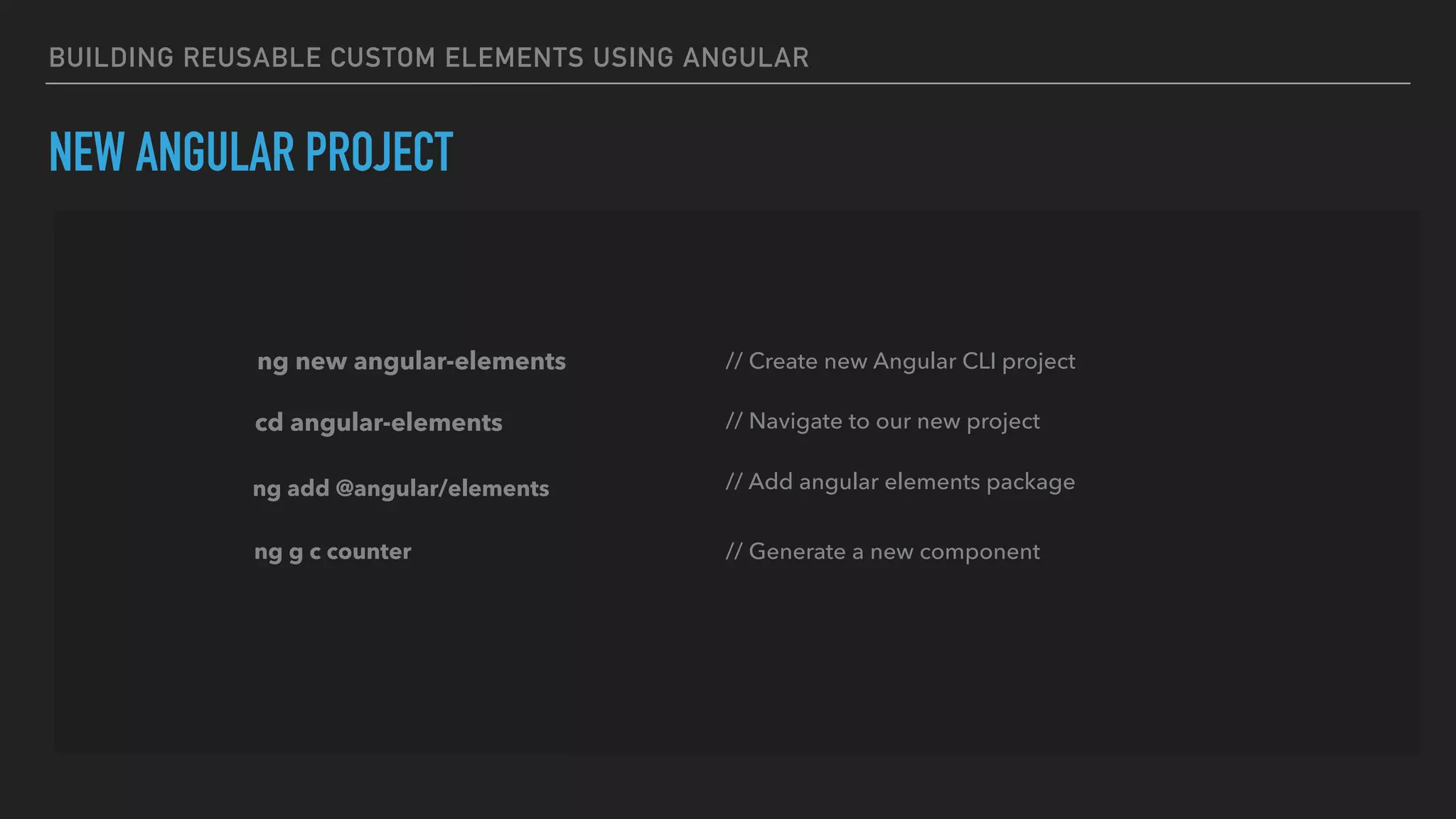
![BUILDING REUSABLE CUSTOM ELEMENTS USING ANGULAR ANGULAR ELEMENTS The generated component @Component({ selector: 'app-counter', templateUrl: './counter.component.html', styleUrls: ['./counter.component.css'], encapsulation: ViewEncapsulation.Native }) export class CounterComponent { @Input() counter = 0; constructor() { } inc() { this.counter++; } dec() { this.counter--; } } src/app/counter/counter.component.ts](https://image.slidesharecdn.com/customelementswithangular-180903103003/75/Building-Reusable-Custom-Elements-With-Angular-46-2048.jpg)
![BUILDING REUSABLE CUSTOM ELEMENTS USING ANGULAR ANGULAR ELEMENTS Add View Encapsulation via Shadow DOM (Native) @Component({ selector: 'app-counter', templateUrl: './counter.component.html', styleUrls: ['./counter.component.css'], encapsulation: ViewEncapsulation.Native }) export class CounterComponent { @Input() counter = 0; constructor() { } inc() { this.counter++; } dec() { this.counter--; } } src/app/counter/counter.component.ts](https://image.slidesharecdn.com/customelementswithangular-180903103003/75/Building-Reusable-Custom-Elements-With-Angular-47-2048.jpg)
![BUILDING REUSABLE CUSTOM ELEMENTS USING ANGULAR ANGULAR ELEMENTS Create a counter input property @Component({ selector: 'app-counter', templateUrl: './counter.component.html', styleUrls: ['./counter.component.css'], encapsulation: ViewEncapsulation.Native }) export class CounterComponent { @Input() counter = 0; constructor() { } inc() { this.counter++; } dec() { this.counter--; } } src/app/counter/counter.component.ts](https://image.slidesharecdn.com/customelementswithangular-180903103003/75/Building-Reusable-Custom-Elements-With-Angular-48-2048.jpg)
![BUILDING REUSABLE CUSTOM ELEMENTS USING ANGULAR ANGULAR ELEMENTS Create counter handlers @Component({ selector: 'app-counter', templateUrl: './counter.component.html', styleUrls: ['./counter.component.css'], encapsulation: ViewEncapsulation.Native }) export class CounterComponent { @Input() counter = 0; constructor() { } inc() { this.counter++; } dec() { this.counter--; } } src/app/counter/counter.component.ts](https://image.slidesharecdn.com/customelementswithangular-180903103003/75/Building-Reusable-Custom-Elements-With-Angular-49-2048.jpg)
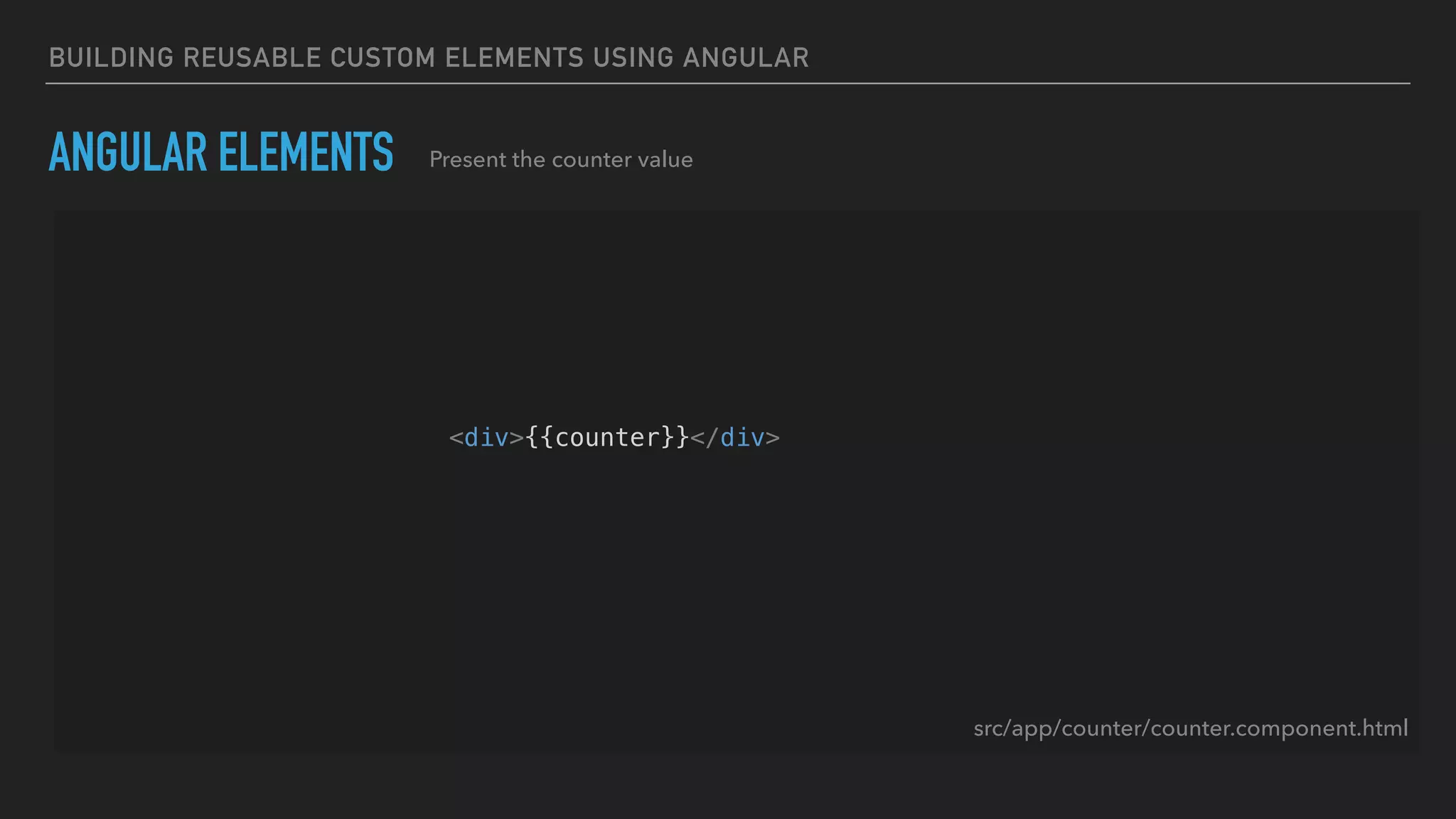
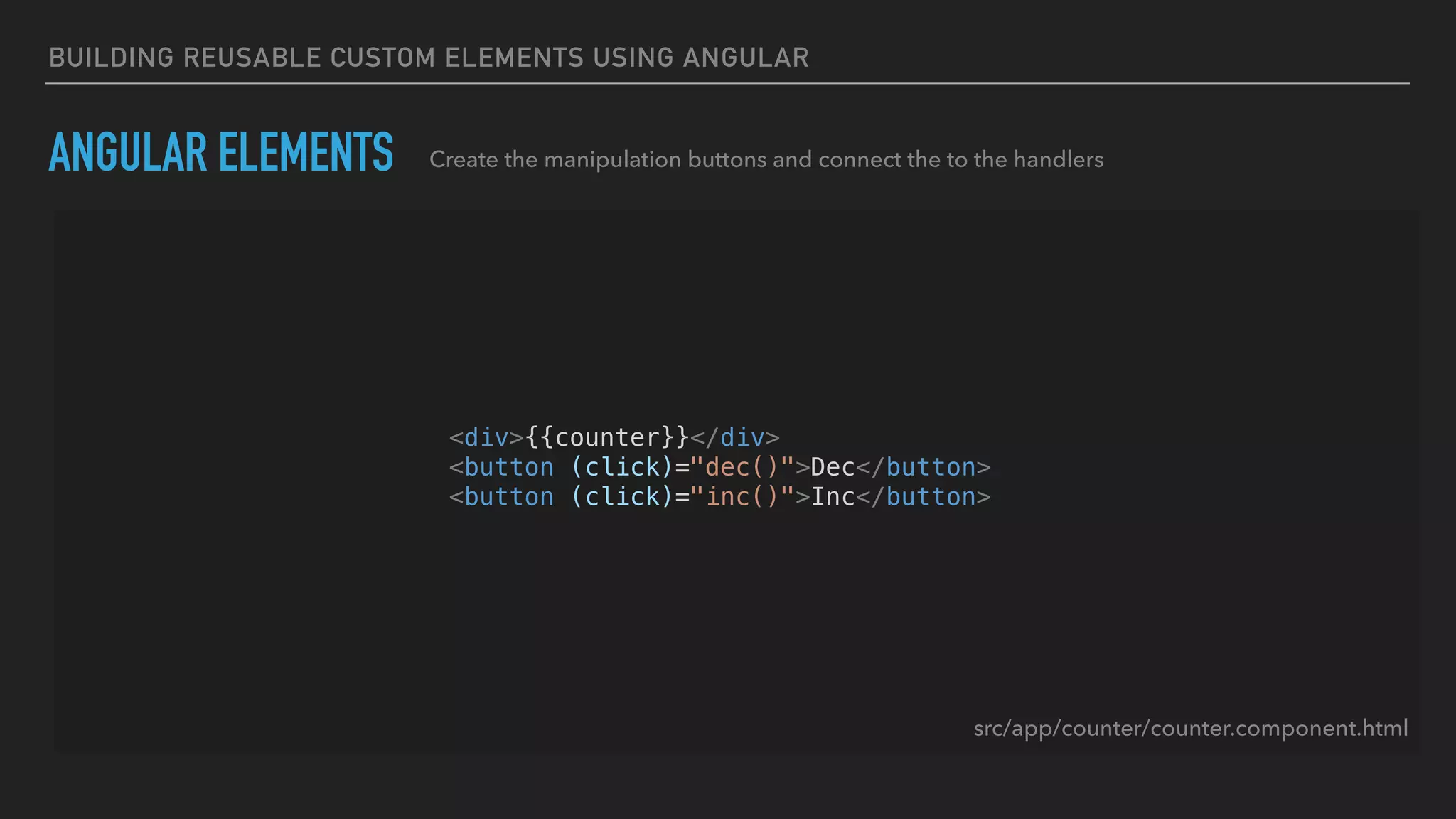


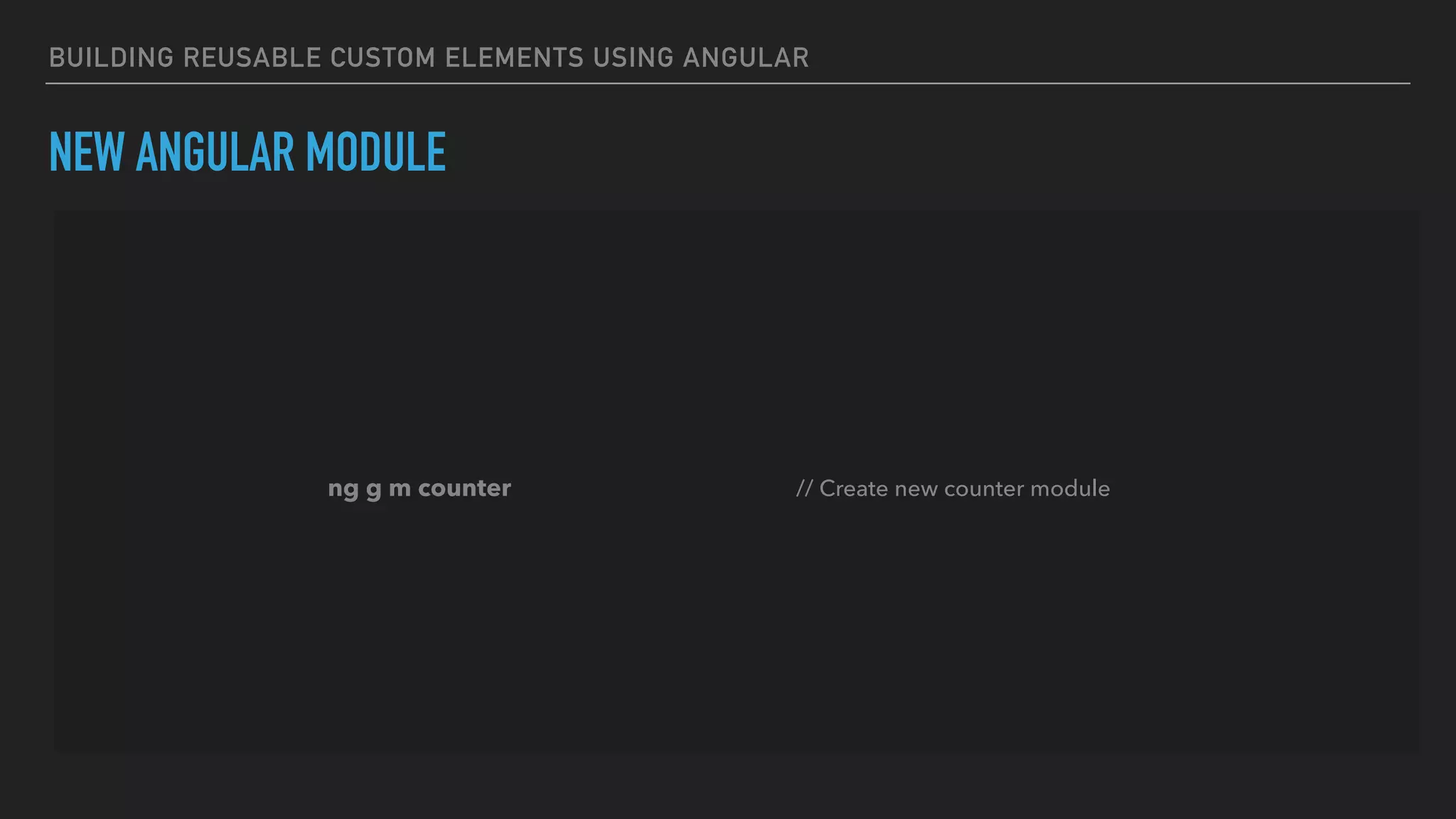
![BUILDING REUSABLE CUSTOM ELEMENTS USING ANGULAR ANGULAR ELEMENTS Create a module for out custom elements @NgModule({ imports: [ BrowserModule ], declarations: [], entryComponents: [CounterComponent] }) export class CounterModule { constructor(private injector: Injector) {} ngDoBootstrap() { const el = createCustomElement(CounterComponent, { injector: this.injector }); customElements.define('app-counter', el); } } src/app/counter/counter.module.ts](https://image.slidesharecdn.com/customelementswithangular-180903103003/75/Building-Reusable-Custom-Elements-With-Angular-55-2048.jpg)
![BUILDING REUSABLE CUSTOM ELEMENTS USING ANGULAR ANGULAR ELEMENTS Create a module for out custom elements @NgModule({ imports: [ BrowserModule ], declarations: [CounterComponent], entryComponents: [CounterComponent] }) export class CounterModule { constructor(private injector: Injector) {} ngDoBootstrap() { const el = createCustomElement(CounterComponent, { injector: this.injector }); customElements.define('app-counter', el); } } src/app/counter/counter.module.ts](https://image.slidesharecdn.com/customelementswithangular-180903103003/75/Building-Reusable-Custom-Elements-With-Angular-56-2048.jpg)
![BUILDING REUSABLE CUSTOM ELEMENTS USING ANGULAR ANGULAR ELEMENTS Create a module for out custom elements @NgModule({ imports: [ BrowserModule ], declarations: [CounterComponent], entryComponents: [CounterComponent] }) export class CounterModule { constructor(private injector: Injector) {} ngDoBootstrap() { const el = createCustomElement(CounterComponent, { injector: this.injector }); customElements.define('app-counter', el); } } src/app/counter/counter.module.ts](https://image.slidesharecdn.com/customelementswithangular-180903103003/75/Building-Reusable-Custom-Elements-With-Angular-57-2048.jpg)
![BUILDING REUSABLE CUSTOM ELEMENTS USING ANGULAR ANGULAR ELEMENTS Create a module for out custom elements @NgModule({ imports: [ BrowserModule ], declarations: [CounterComponent], entryComponents: [CounterComponent] }) export class CounterModule { constructor(private injector: Injector) {} ngDoBootstrap() { const el = createCustomElement(CounterComponent, { injector: this.injector }); customElements.define('app-counter', el); } } src/app/counter/counter.module.ts](https://image.slidesharecdn.com/customelementswithangular-180903103003/75/Building-Reusable-Custom-Elements-With-Angular-58-2048.jpg)
![BUILDING REUSABLE CUSTOM ELEMENTS USING ANGULAR ANGULAR ELEMENTS Create a module for out custom elements @NgModule({ imports: [ BrowserModule ], declarations: [CounterComponent], entryComponents: [CounterComponent] }) export class CounterModule { constructor(private injector: Injector) {} ngDoBootstrap() { const el = createCustomElement(CounterComponent, { injector: this.injector }); customElements.define('app-counter', el); } } src/app/counter/counter.module.ts](https://image.slidesharecdn.com/customelementswithangular-180903103003/75/Building-Reusable-Custom-Elements-With-Angular-59-2048.jpg)
![BUILDING REUSABLE CUSTOM ELEMENTS USING ANGULAR ANGULAR ELEMENTS Create a module for out custom elements @NgModule({ imports: [ BrowserModule ], declarations: [CounterComponent], entryComponents: [CounterComponent] }) export class CounterModule { constructor(private injector: Injector) {} ngDoBootstrap() { const el = createCustomElement(CounterComponent, { injector: this.injector }); customElements.define('app-counter', el); } } src/app/counter/counter.module.ts](https://image.slidesharecdn.com/customelementswithangular-180903103003/75/Building-Reusable-Custom-Elements-With-Angular-60-2048.jpg)
![BUILDING REUSABLE CUSTOM ELEMENTS USING ANGULAR ANGULAR ELEMENTS Create a module for out custom elements @NgModule({ imports: [ BrowserModule ], declarations: [CounterComponent], entryComponents: [CounterComponent] }) export class CounterModule { constructor(private injector: Injector) {} ngDoBootstrap() { const el = createCustomElement(CounterComponent, { injector: this.injector }); customElements.define('app-counter', el); } } src/app/counter/counter.module.ts](https://image.slidesharecdn.com/customelementswithangular-180903103003/75/Building-Reusable-Custom-Elements-With-Angular-61-2048.jpg)


![BUILDING REUSABLE CUSTOM ELEMENTS USING ANGULAR ANGULAR ELEMENTS Using the Ivy hopefully we will have something like: @Component({ selector: 'app-counter', templateUrl: './counter.component.html', styleUrls: ['./counter.component.css'], customElement: true }) export class CounterComponent { @Input() counter = 0; constructor() { } inc() { this.counter++; } dec() { this.counter--; } } src/app/counter/counter.component.ts](https://image.slidesharecdn.com/customelementswithangular-180903103003/75/Building-Reusable-Custom-Elements-With-Angular-64-2048.jpg)
